Narrabeen Prawning Times - A Seasonal Tide of Returnings
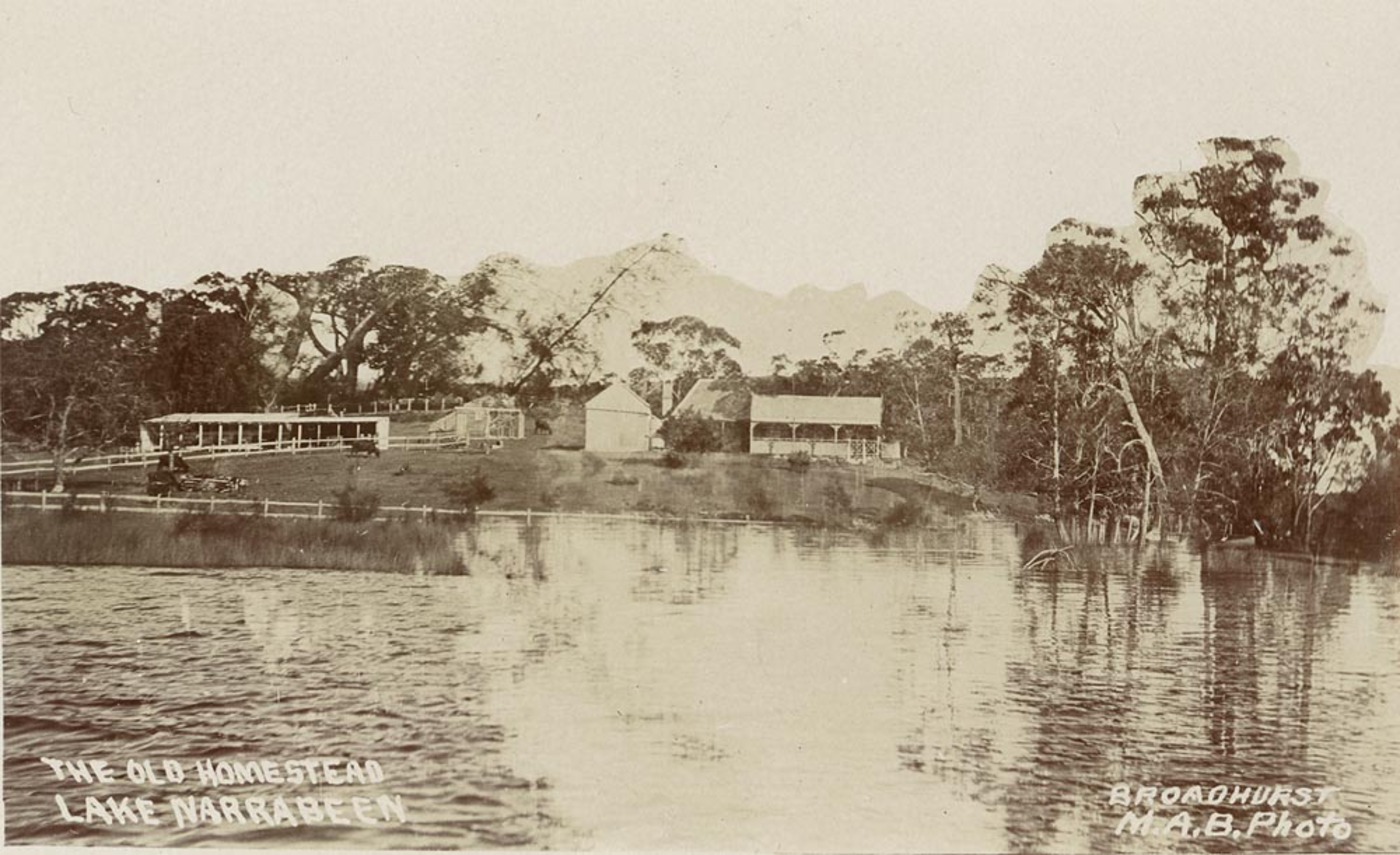
The Old Homestead, Lake Narrabeen, from the Broadhurst Scenes of Narrabeen Album, Image no.: a116483, courtesy State Library of NSW.
MRS. HANNAH WHEELER. Mrs. Hannah Wheeler, wife of Mr. George Wheeler, one of the older residents of Manly and district, died recently at her home Delmar, Pittwater-road, Deewhy. The Wheeler family have been landholders in the Manly, Deewhy, and Narrabeen districts since 1836, where the late Mr. James Wheeler made extensive purchases, the family being established at The Homestead, at the top of Narrabeen Lake. Mrs. Wheeler went to reside at Deewhy many years ago, when the coach was still the principal means of communication in the Warringah district. She leaves six sons and four daughters. The interment took place in the Manly Cemetery. MRS. HANNAH WHEELER. (1930, August 2). The Sydney Morning Herald (NSW : 1842 - 1954), p. 20. Retrieved from http://nla.gov.au/nla.news-article1669265
While finishing the research for our Spring run of history pages, and having already decided it's time we revisited some of the years of yore of Pittwater's watery environments, the Hon. Katrina Hodgkinson, current New South Wales Minister for Primary Industries, announced as part of an ongoing initiative to bring lots of life back to our waterways under the NSW Marine Fish Stocking Program, that four million juvenile king prawns are to be released into ten estuaries this Summer, and Narrabeen Lagoon will be one of these.
An inquiry as to how many for Narrabeen and when during Summer brought the response that our query will be answered closer to their release date. We do hope to photograph the great pouring in for you...
This great news did inspire us to run Narrabeen Prawning Times first though... having heard from Peter Verrills and Tom Gilbert of their childhood wadings along Station Beach under Barrenjoey with their families netting this scrumptious, of hunkering down on the beach's edge and cooking them in readily available saltwater the whole Gonsalves, Verrills and Gilbert families enjoyed, the smell of fishing with our own families rose up and wrapped us in all those places and times we too had been part of - this is a true family garden, going fishing or prawning together, one all of us may have been fortunate enough to visit, and as the Three Way Competition for 2014 between Narrabeen, Newport and Avalon is also taking place with a big weigh in at the Newport Arms today (Sunday 14th of September), it seems more than a good idea to cast our eyes back even further to why Narrabeen Lagoon has been chosen as a place for potential prawning and fish rising thereafter success.
Prawns, apart from being one of many people's favourite foods, are of course the favourite food of most carnivore fish - if you want to catch decent sizes of these, and catch more than one or two as per regulations, then they too must have something to eat.
In Narrabeen's waterbody the fish, and all they ate, and their abundance, are attested to from earliest European settlement times. Mr. Charles De Boos, however, did not fare as well as he may have in seeking repast, as attested to in through the installments of the My Holiday series of articles which ran in 1861, until he went 'candling' at Newport Reef. He does, however, provide a nice description of the surrounds of Narrabeen:
The road now led us along a swampy honeysuckle flat for rather more than half a mile, and then brought us on to the margin of the Narrabeen lagoon. Narrabeen is a somewhat extensive lagoon, connected with the sea by broad sandy flats covered by the tide at high water, but hire at low water, with the exception of a distance of about twenty rods in width, forming a channel by which the surplus water of the lagoon runs out into the sea. The opening to the sea is somewhat narrower than this, though deeper, taking a man to the waist in wading over, whilst at the regular crossing-place the stream at low water is not much over the knee. It is situated between the island fall of the high precipitous ridge that, jutting far out into the ocean, forms Narrabeen Head to the north; and to the south, the long low sandy beach that extends northerly from the Long Reef. The large sheet of water that forms the lagoon is situated some two miles from the sea, with which the sandy flats connect it, although at high water, and particularly at spring tides, one broad expanse of water extending in one continuous sheet from the ocean into the interior for a distance of five miles is presented to the view, forming a magnificent lake, by no means wanting in picturesqueness and rude grandeur in some portions of it. Where the road crosses, the country for some distance around is flat, and consequently tame, and the picture is rendered sombre by the low, thick growth of ti tree that fringes the water line, and the dark leaved honeysuckles of the flat land beyond ; but higher up, where the fresh water of the lagoon commences, where ranges clad with giant timber come down to its margin, and where numerous gullies with the rich, dank jungle vegetation of the tropics, including the cabbage-tree palm, the fern tree, the bengola, and wild vine, empty their watery contributions into it wild landscape views might be taken fully equal to many of those about which artists have raved so much.
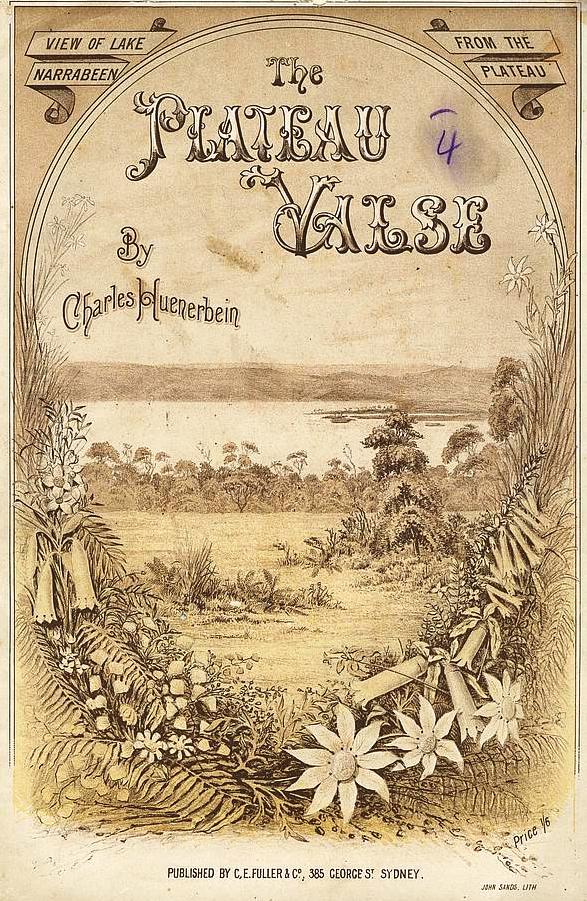 Right: The Plateau Valse [music] - 1880 - 1889 (9 pages - cover shown) by Charles Huenerbein, courtesy National Library of Australia
Right: The Plateau Valse [music] - 1880 - 1889 (9 pages - cover shown) by Charles Huenerbein, courtesy National Library of Australia
I have said that the morning was cloudy, and consequently the sun, not yet very high, was overcast and as we came down to the channel, over which we had to cross, the wind swept coldly over the sandy beach, making the task of stripping and crossing anything but a pleasant one. Under the circumstances, the twenty rods of width-for luckily we had hit the extreme low water - appeared, in my eyes a mighty waste of waters, and in the absence of guide or direction, it seemed a somewhat dangerous experiment to venture upon, particularly as the water was evidently running out with great swiftness.
"Oh," said Tom, as I expressed my doubts, " there's no danger; its all right !"
So we sat down, pulled off boots and stockings, and tucked up our trousers as high as we could ; but I noticed that with all his boasting, Master Thomas loitered considerably over his preparations, growling audibly over "those blessed boots," the getting on again of which he declared to be a matter of considerable doubt. Tom grumbled and fumbled so long, that Nat, declaring that "he wasn't going to wait getting cold through for him," took the lead in the advance, walked nonchalantly into the water and made steadily for the other side. I watched him with fear and trembling, expecting every minute to sea him disappear, but, as I perceived that he got half-way over with the water only up to Ins knees, I took heart of grace and ventured in. But oh the terrible agony of that first plunge! The water was as cold as if it had been fresh melted snow, and my feet, having been warmed by the brief walk, felt the change most bitterly. But on and on I went, the chill of the water biting in rising circles round my legs as I got deeper and deeper in the stream, causing an agony unspeakable. Just as I was about half-way across, I turned round in order to see by the distance I had passed how long this torture was to be continued and there I beheld Tom, all ready for the passage, peeping out at us through the bushes. He caught my eye, and shouted "Tell us if it gets any deeper!
The old dodger had quietly pushed us on ahead, in order, as he said, that we might take soundings for him. I made him no answer, for I was too full of my own especial sufferings just at that moment j and, i without joke, it was as painful an ordeal, in regard to mere corporeal pain, as ever I went through m so brief a time. In fact, so acute was it, that I felt as I neared the end of my torture as if I could not possibly hold out until I got out of that blood-chilling stream, but that my feet must give way, and that I must fall. However, across I did get, without the fall that I considered inevitable, and it was only by looking down at my feet and seeing them there doing duty, that I could assure myself that I still possessed those appendages. The feeling I experienced on quitting the water was as if feet ankles and legs had been cut off, just at the place where the water had reached highest, with a red hot saw. Though I looked down occasionally to assure myself of the fact that I still possessed them, it was only after a ten minutes' run upon the sand that any sensation of feeling in those useful members made assurance doubly sure; and during the whole of the day I felt that burning ring round my leg, sometimes with painful distinctness.
There was a large flock of sand pipers, small birds, somewhat about the size of a lark, but with long lags like a snipe, that were running about the sand picking up their morning meal. I tried very hard to got a shot at them, .but they ran away so fast and kept themselves so pertinaciously out of gun-shot that at last I let fly haphazard at them, and of course got nothing.
We now made for the opposite bank of the stream, where, above high watermark, the grass grew in thick coarse tufts forming a convenient towel with which to wipe the sand from our feet, and here we once more resumed boots and stockings, and got into marching on, though not before Tom had had a desperate struggle with his rebellious watertights, in which, from dread that in the end the boots would get the best of it, we were at last fain to join, and so by dint of numbers gained the mastery. Tom seemed quite proud of his achievement, and stalked along in consequence quite boastfully for the rest of that day's journey.
We had hung our loads on the posts of a fence that skirted the edge of the sand, and which enclosed paddock of long reedy grass, as high as a man's waist though beyond some gently undulating land the crest surmounted by a not very neat but substantial looking slate dwelling, rose up from the marshy plain, and appeared to be rich cultivated land. We were about to take our loads from the temporary pegs on which they hung, when we were joined by another wayfarer, who, like ourselves, had just crossed the lagoon, and came up to us to reconnoitre.
"Shooting?" asked he.
"Yes," answered Tom, "if we can act anything to shoot."
" You didn't ought to want for plenty to shoot here away," he responded, and I ought to have stated that the new arrival was evidently of the sea, sailory. About this, there could be no doubt, even at the first glance.
...
" Whose place was this ?"
" This ?-why, this was Collins'."
And now we approached a tender point-one upon which we all felt, I won't say tenderly, because we didn't, but ravenously.
" Didn't he know where we could beg, borrow, of steal apiece of meat, salt or fresh?"
He shook his head doubtingly. We had evidently given him a puzzler. Ducks, wallabi, or pigeons could be mapped out with a wave of the hand, but the location of meat, which I had always deemed an indispensable requisite to man's carnivorous nature, was not so readily to be pointed out.
At last he said, "You see meat is rather a scarce article 'n these parts. They have to bring it all the way from Sydney for they can't always get it at Manly, and in consequence they often run out of it. It's hard to say, where you'll get any. But" and here he brightened up a bit, and, of course, our countenances which had got ruefully long during this speech, brightened a little also,-"come up to Collins'; if he's got any, he'll let you have some."
"Is this Collins' place here?"
"Yes," answered the sailor, "he's a very decent fellow too." And so to Collins', under the guidance of our nautical acquaintance we determined to go, and with something like hope in our hearts shouldered our loads. MY HOLIDAY. (1861, July 1). The Sydney Morning Herald (NSW : 1842 - 1954), p. 2. Retrieved from http://nla.gov.au/nla.news-article13061639
The 'sailory' aspect of the man Mr. De Boos and his companion 'Tom' encountered may be explained thus:
WATER POLICE COURT.-Tuesday. BEFORE the Water Police Magistrate, Mr. Deloitte, and Mr. Cooper. Thomas Collins, of Narrabeen, was, upon the information of Martin Wilson, fined £5 with 6s, 6d. costs of Court, for employing Olaff Olson ; £10 with costs, for employing Gustave Berry, and the same penalty for engaging Charles Jackson, the employees being deserters from the AEtos. A similar charge against the same party was withdrawn. WATER POLICE COURT.—Tuesday. (1860, March 7).Empire(Sydney, NSW : 1850 - 1875), p. 5. Retrieved from http://nla.gov.au/nla.news-article60406807
And who else may have been hunting and fishing there, during these 'scarcity of meat' days in Pittwater?;
A female lyre-bird (menura superba), from Pittwater. Mr. James Wheeler. DONATIONS TO THE AUSTRALIAN MUSEUM DURING AUGUST, 1856. (1856, September 8). The Sydney Morning Herald (NSW : 1842 - 1954), p. 2. Retrieved from http://nla.gov.au/nla.news-article12986771
A White Heron (Herodias syrmatophorus) from Pittwater, by Mr. James Wheeler, St. Leonard's. DONATIONS TO THE AUSTRALIAN MUSEUM DURING SEPTEMBER, 1858. (1858, October 8). The Sydney Morning Herald (NSW : 1842 - 1954), p. 5. Retrieved fromhttp://nla.gov.au/nla.news-article13016767
James Wheeler, farmer, Narrabeen Lagoon, was on the information of John Redman, farmer, residing at Pitt Water, charged with having wilfully removed certain Government landmarks, namely, a corner-pin or stake from certain ground near Pittwater, this landmark having been erected by a licensed surveyor, and it not being necessary to re-move it for fencing or improving the land. Mr. W. Redman appeared for informant, Mr. Burton for defendant. It appeared from Redman's evidence that the peg in question was placed at the corner of defendant's land, and formed one of a line separating witness' land and land owned by defendant. Red-man did not see Wheeler pull up the peg, but when he told Wheeler that he should proceed against him for doing so, Wheeler said if he had been present when Mr. Neal (the Government surveyor) put it down he would then have pulled it up. There was another peg close to the corner peg pulled up, Redman's reason for instituting this proceeding was because defendant was trying to encroach on his land by claiming a line of eight feet in advance of his proper boundary. Several witnesses in corroboration of this evidence, and others in defence, were heard; when their worships considered the charge was made good, and fined defendant 40s., with costs of Court and professional costs of prosecution. WATER POLICE COURT. (1860, March 28). The Sydney Morning Herald (NSW : 1842 - 1954), p. 5. Retrieved from http://nla.gov.au/nla.news-article13038437
And were these 'law unto ourselves' types fishing?; some of them were, or trying to, as were others;
METROPOLITAN DISTRICT COURT. MONDAY BEFORE Mr District Court Judge M'Farland and a jury of four.
Skinner v Wheeler
This was an action to recover damages for maliciously destroying the fishing nets and sinking the boat of the plaintiff. Damages were laid at £200. The defendant pleaded a number of defences, the principal of which amounted to averments that the lagoon where the plaintiff was fishing was not an arm of the sea, that the land where the alleged trespass was committed was the property of the defendant, and that the defendant was not guilty of the acts set forth in the plaintiffs declaration. Mr Fisher and Mr Pilcher, instructed by Mr Dawson, appealed for the plaintiff, and Mr Redman for the defendant . The plaintiff was a fisherman, living at Manly Beach and the defendant was a farmer, living near the Narrabeen Lagoon, situate between Manly Beach and Pitt Water. The plaintiff, at certain periods of the year, sent fishermen with a boat and nets to the lagoon. For some months, as he alleged, the fishing on the lagoon was very good, and at those times, his average profits from this source were £1 10s a week. The plaintiffs boat was sunk in June, 1867. Plaintiff was informed by the defendant in a letter that the latter suspected foul play and recommended him to come to the lagoon to look after his boat. Plaintiff, on going to the lagoon, discovered his boat by part of his fishing net floating on the surface. The other portion of the net was battened down in the bottom of the boat, which had been filled with stones and sunk in twelve foot of water. Plaintiff's man borrowed defendant's punt to look for the boat, and in it there was some sawdust of timber corresponding to the wood of the battens fastening the net in the boat, and one of the witnesses for the plaintiff stated that, on his way to the defendants, he saw pieces of wood, the sawn ends of which corresponded to one or two of the pieces in the boat. In June, 1868, the plaintiffs men began to fish there again. At first there was nothing in the bed of the lagoon to impede the sweep of their nets, but afterwards the lagoon was filled with snags, and some thirty times or more the net was injured. One of the witnesses for the plaintiff swore that the defendant told him that he would not allow him or Skinner to fish in the lagoon, and that if he could not prevent it by fair means he would by foul. According to this witness (Eaton) - and his evidence in what follows was corroborated by a man named Pashley, and by the defendant's son - on the 23rd of July, he, Pashley, and Skinner, junior, were fishing on the lagoon, when they saw the defendant and his son in a boat. They saw Wheeler throw five snags from his boat into the lagoon, in different places where they usually dragged the nets. The defendant and his son then rowed to the shore, cut down three other small trees, carried them down to the boat and cast them into another part of the lagoon. The plaintiff's boat was at this time about fifty yards away from the last of the five snags, and about four hundred yards away from the last of the three. Two specimens of the snags were brought into Court. They were young forest oak trees, about ten feet long, and the boughs were pointed, apparently, with a tomahawk. The defendant and his son swore that they did not throw the snags into the lagoon, and that on that particular day, the 23rd July, they were engaged in cutting shingles. Defend-ant also alleged that in June, 1867, he was out shooting when he happened to see the plaintiff's net on the water, and he went out of his way to tell him of it. There were two or three other punts in the neighbourhood of the lagoon in June, 1867, one of which defendant believed was actually on the lagoon at the time. His own punts were often taken away and used without his permission. Evidence was given to show that the trees produced might have been washed into the lagoon by floods, and that they might have been cut down for the purpose of forming a cockatoo fence. Defendant called witnesses to discredit the character of the witnesses called for the plaintiff. One of these witnesses confessed that he had himself been charged with murder. The evidence as to the value of the boat and the nets, as well as to the nature of the fishery, was contradictory. There was evidence to show that the Narrabeen Lagoon was affected by the ebb and flow of the tide; and the defendant's plea of locus in quo was disallowed, on the ground that it was tantamount to a justification, and was, therefore, one of those defences which were not admissible excepting on five days notice being given. The jury found a verdict for the plaintiff, and assessed the damages at £10.METROPOLITAN DISTRICT COURT. (1868, October 20). The Sydney Morning Herald (NSW : 1842 - 1954), p. 2. Retrieved fromhttp://nla.gov.au/nla.news-article13174512
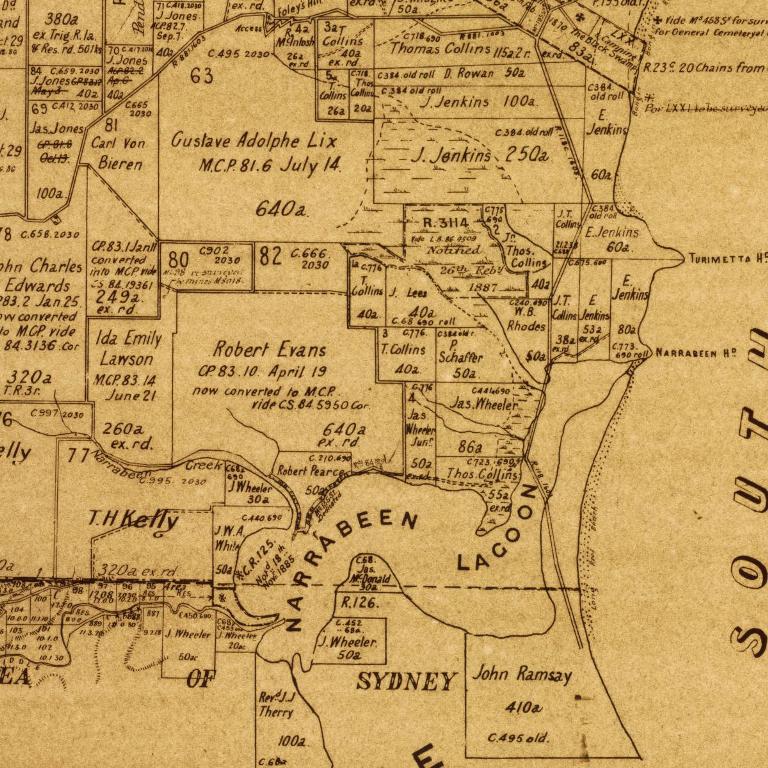
Enlargement of peice of Parish of Narrabeen, County of Cumberland [cartographic material] : Metropolitan Land District, Eastern Division N.S.W.
1886. MAP G8971.G46 svar (Copy 1). Showing placement of 'Collins' Lagoon side and 'Black Swamp' - Mona Vale (Turimetta).
James. Wheeler, the elder, James Wheeler, the younger, and Frank Poyner appeared pursuant to summons wherein they were charged that on the night of the 5th instant, at Narrabeen Lagoon, near Pittwater, they did wilfully and maliciously destroy a fishing net, the property of James Wilson. Mr. Gannon appeared for the complainant, and Mr. R. Driver for the defendants. Several witnesses were examined for the complainant, and the case was adjourned till tomorrow week. WATER POLICE COURT.—MONDAY. (1871, October 24).Empire (Sydney, NSW : 1850 - 1875), p. 2. Retrieved from http://nla.gov.au/nla.news-article60877416
Destroying a Fishing Net. — The Pitt Water People Again. James Wheeler, the elder, James Wheeler, the younger, and Frank Poyner were charged with having, at Narrabeen Lagoon, near Pitt Water, destroyed a fishing net of the value of L5, the property of James Wilson. Mr. Gannon appeared for the complainant, and Mr. Driver for the defence. The evidence disclosed that on the night of the 5th instant, between 10 and 2, the fishing party, consisting of Wilson, Sly, and Pashley, were camped in a gunyah on Miss Jenkins's property, which runs down to Narrabeen Lagoon. Pashley was aroused by hearing a peculiar whistle, and called Sly, who aroused Wilson. Pashley and Sly went out through some rushes to where the net with which they were fishing was stretched out to dry. They there saw the two Wheelers and Poyner standing on the net. The younger Wheeler came off the net and walked towards them, close to the rushes.
They saw Poyner with a can or jar in his hand. He poured something out of the can on to the net. They were on the net about ten minutes, and then went away. When Sly called Wilson, he (Wilson) went in the direction of the only path anybody could take from the net, to get away from the lagoon, and saw the elder Wheeler running away from the net. He also saw two other men, but could not tell who they were. In the morning they examined the net, and took it up in their hands, but it fell to pieces. Evidence was given that sulphuric acid (oil of vitriol) had been poured on the net. The defence set up was that Wheeler and his son never left their house, at Narrabeen on that night, and that Wilson stated he did not know whether it was old or young Wheeler that he saw. The witnesses for the complainant were Wilson, Pashley, Sly, and Mr. Watt, Government Analytical Chemist; and for the defence, Mrs. and Miss Wheeler, John Farrell, Mileswater, and Skinner. — The bench disagreeing, there was no adjudication. Thomas Wilson, of Mona Vale, Pitt Water, complained that on the 6th instant, Sarah Farrell temporarily impounded four head of cattle, and neglected to feed and maintain them. — The case was not concluded when we went to press. — Mr. Redman appeared for the complainant, and Mr. Driver for the defence. Police Courts, This Day. (1871, October 31). Evening News(Sydney, NSW : 1869 - 1931), p. 2. Retrieved from http://nla.gov.au/nla.news-article129969185
Before Mr. Hale. James Thomas Pashley was charged by James Wheeler, the elder, of Narrabeen, farmer, for that he did on the 23rd day of October, at the Water Police Court, during the hearing of the cause Wilson v. Wheeler and others, falsely, wickedly, wilfully, and corruptly commit wilful and corrupt perjury. The information further stated that prosecutor had reason to believe that defendant was about to leave the colony. Mr. Hellyer appeared for the prosecution; and defendant, who pleaded not guilty, was represented by Mr. David Buchanan (instructed by Messrs. Gannon and Curtis). James Wheeler, the elder, deposed : I am a farmer and house proprietor, residing at Narrabeen; I have lived there about thirty years, and was there on the 5th October last ; on the night of that day I was at my residence, and did not see Pashley at all during the day ; the nearest part of Miss Jenkins's property is about a mile and a-half from my house ; there is a place called the Fisherman's Hut, on Miss Jenkins's property; I remember seeing a net there on the Thursday; I was charged before Mr. Cowper and Mr. Williams with destroying the net ; the net covered 500 yards from one end to the other; on the 5th October I was not at the Fisherman's Hut, either at dark or at any other time; my wife, daughter, and sons, were stopping with me that night, and Poyner was on the premises that day, having come there the previous night ; Poyner was there on the night of the 5th ; Poyner left my house on the night of the 5th October to go to the net house, where he slept, and I did not see him after that ;my son James Wheeler was at home on the night ofthe 5th October, and went to bed before I did ;he retired somewhere about 10 o'clock ; I was not out of the house after 10 o'clock that night ; on the night of the 5th October I was not off my premises withat the said Frank Poyner ; I did not go to Wilson's net ground of Miss Jenkins, near night ; I was not on the night, nor was I on the net; I was not on the net with Frank Poyner that night, nor did I on that night say tohim while standing on the net, " Here's the bunt, Frank ; " the night of the 5th October was stormy, and bad weather. James Wheeler the younger, son of last witness, gave evidence in corroboration of prosecutor's statement that neither he nor his father left the house on the 5thOctober after going to bed, and did not see a net at the fisherman's hut on Miss Fisher's property on the 5th October. Francis Poyner gave similar evidence, and the case was adjourned until Friday next. WATER POLICE COURT. (1871, November 28). The Sydney Morning Herald (NSW : 1842 - 1954), p. 3. Retrieved from http://nla.gov.au/nla.news-article13248411
METROPOLITAN DISTRICT COURT. WEDNESDAY. BEFORE Mr. District Court Judge SIMPSON.
WILSON V. WHEELER.
This was an action for malicious prosecution, in which the plaintiff, James Wilson, sued the defendant, James Wheeler, for £200 damages. Both parties resided near Manly Beach, at a place called Narrabeen, to the north of Manly. The plaintiff, who carries on business as a fisherman, went, on the 5th of October last, to a lagoon near defendant’s residence, with three other men, for the purpose of trawling a net. About an hour before sunset, the net having been taken out of the water, was spread on the grass to dry ; and plaintiff and his companions lay down to sleep (camping out) about8 or 9 o'clock. In the middle of the night, plaintiff's attention was called by one of the men with him named Pashley, to something going on in the vicinity of the net. Wilson, Ashley, and Sly got up, and went to see what it was. A boy who was with them did not go to see the net. Plaintiff then saw defendant and some other men running away. On examining their three nets immediately afterwards, portions were found to have been destroyed by some kind of acid. Plaintiff summoned defendant and his son to the Police Office for wilful destruction of property, and they were ordered to pay a fine, together with the cost of proceedings. Some time after (in November last) the defendant in this case took proceedings against the plaintiff, and the two other persons (Pashley and Sly) for perjury. Plaintiff was accordingly apprehended at Manly Beach on a warrant (the defendant having sworn that the plaintiff was about to leave the colony), lodged in the lock-up at Manly, brought to Sydney, and lodged in the Cumberland-street watch-house. Having been brought before the Central Police Court, Wilson was committed for trial. He was not tried, however, as the Attorney-General declined to prosecute. Out of these proceedings for perjury the present action arose. It being necessary in actions of this nature to prove the " determination " of the previous case, a question arose as to the admissibility of the formal memorandum of nolle prosequi endorsed on the back of the copy of proceedings forwarded from the Police Office. The counsel on one side contended that the endorsement of the Attorney-General would be sufficient proof of the " determination " of such a case ; and the learned counsel for the defence (Mr. Butler) denied that such determination could be proved otherwise than by direct evidence. The Judge said that his impression was that such an endorsement would not be evidence ;at the same time supposing the Attorney-General was not in Court, he (the Judge) did not see how the matter could be proved in any other way. He could see very great inconvenience resulting from proposing to call on the Attorney-General in such cases. He ruled that the evidence produced to be tendered was admissible, until cause to the contrary should be shown. The man Pashley gave evidence confirmatory of the evidence of the plaintiff.
Mr. Plunkett (secretary to the Attorney-General), having been called, was asked several questions by the counsel for the plaintiff as to the memorandum endorsed on the record of evidence (taken at the Police Office) when the Attorney-General declined to prosecute. These questions were all objected to by Mr. Butler, whose objections were sustained by the Court. Mr. Plunkett stated that a memorandum was made in the " Deposition Book" in all cases when the Attorney-General declined to prosecute. That book was kept by a clerk, as a matter of reference. The book was produced, but the making evidence of the entry therein as to the determination of the case alluded to was objected to by the counsel for the defence. The witness was then asked by Mr. Salomons, whether the Attorney-General had directed a letter to be written to the Bench of Magistrates stating that the Attorney-General did not intend to prosecute in the case of the Queen v. Wilson, for perjury. The witness answered (subject to objection)that he had received written instructions from the Attorney-General to write the letter produced. This answer was objected to by the opposing counsel, and rejected as evidence by the Court. There was no other memorandum made but that on which the letter had been written, according to the practice of the last eighteen years. George Sly's evidence was corroborative of that given by Wilson and Pashley about the net. The case was not terminated when the Court rose at 4.30 p.m. METROPOLITAN DISTRICT COURT. (1872, March 28). The Sydney Morning Herald (NSW : 1842 - 1954), p. 2. Retrieved from http://nla.gov.au/nla.news-article13254992
George Sly is of course the father of the Fairy Bower residents who were responsible for the advent of early fishing boats and whalers being used as rescue boats on Manly Beach, and over a hundred years of surfboat history since...See: Surf Bathing and the Advent of Manly’s First Surf Carnival - 1907
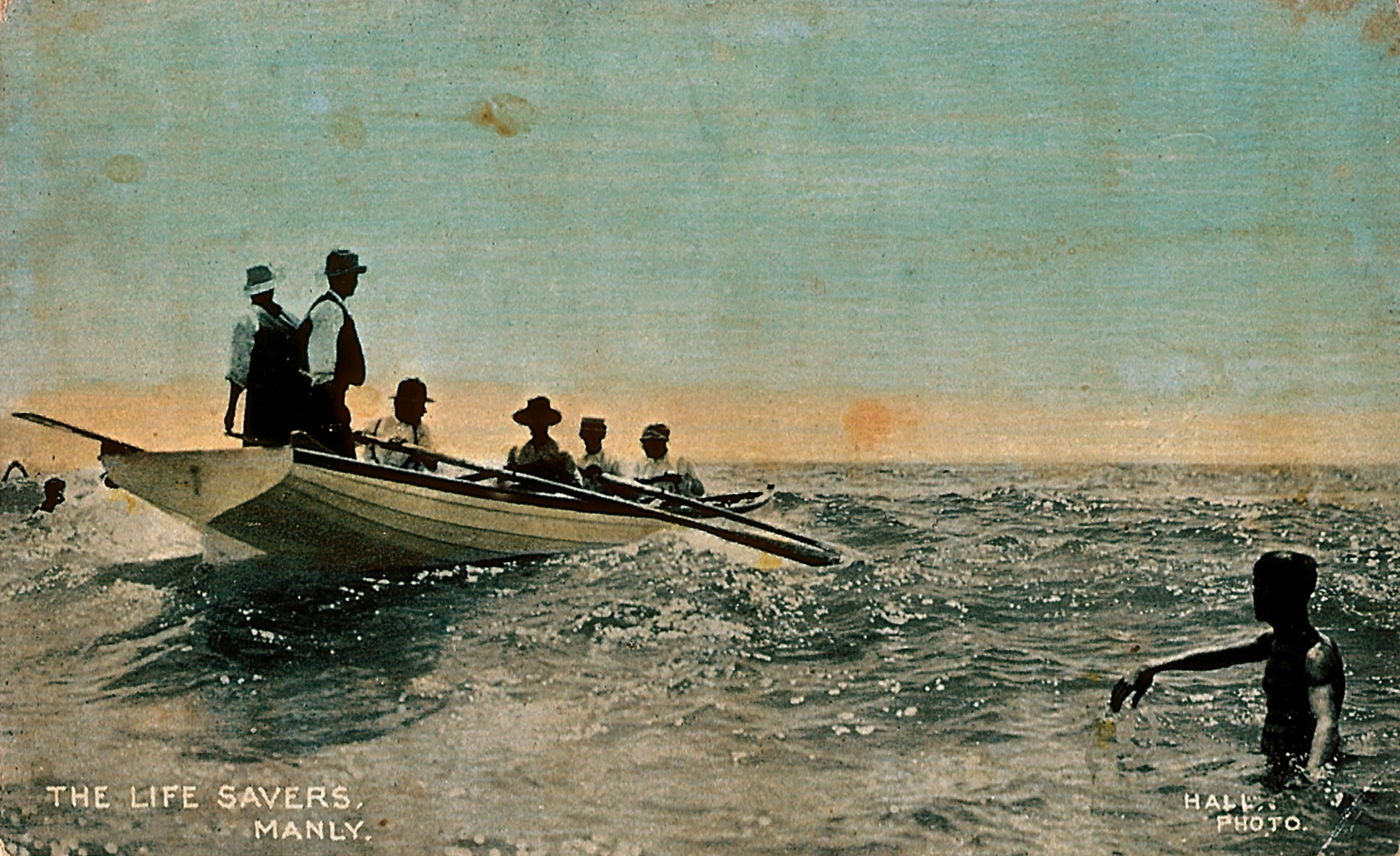
This photographic postcard is titled ‘The Lifesavers, Manly’, and is referring to the Sly brothers. The Sly brothers were fishermen from Fairy Bower, who, in 1903, received funding from Manly Council to build a modified whaleboat to patrol Manly and nearby beaches. The image used for this postcard was taken by William Hall photographic studio, Sydney. The photo was taken in 1907/8. Object number: 00001991, courtesy the Australian National Maritime Museum’s William J Hall collection. Visit: Pittwater Fishermen: The Sly Family and The Sly Family Of Manly and Narrabeen + The First Surfboat At Manly
You'd be hard pressed not to believe the early generations Wheelers, Collins (of Narrabeen) and Farrells were a plague upon all those not out to drive others from their lands, destroy property, steal and wanting simply to live a decent, peaceful life in early Pitt Water - however, these early cases clearly demonstrate those residing here were not going to be bullied and stay silent and that Narrabeen Lagoon was fished with nets and the catch taken to market from earliest settlement times.
And in one of these cases an indication of James Wheeler's sense of ownership of the lagoon and all in it surfaces:
The case against Joseph Forester and George Sly for a breach of the Fisheries Act Amendment Act, 81 Vic, No. 10, section _,was resumed at the Water Police Court, yesterday, before Messrs. Marsh and Field. Water police constable Turner gave evidence corroborative of that of constable Skinner, and sketches of the lagoon wore produced. Mr. J. M. Curtis, for the defendants, took an objection that Narrabeen Lagoon, where the offence was alleged to have been committed, was not an estuary according to the real definition of the term; but the Board overruled the objection. The point had been decided in a previous case in the affirmative. Mr. Curtis also raised the question of title. Mr. Wheeler was the owner of the lagoon, and the defendants were employed by him, and had a perfect right to fish in the lagoon with any sized nets they chose to use. At this stage the case was again postponed for a week. NEWS OF THE DAY. (1880, December 10). The Sydney Morning Herald (NSW : 1842 - 1954), p. 5. Retrieved from http://nla.gov.au/nla.news-article13484199
The Fisheries Act referred to in the above item stems from:
THE FISHERIES BILL.
The following is the bill, brought in by Mr L. L. Smith and Mr Nicholson, for the purpose of amending the law for the protection of the fisheries of the colony of Victoria : —Whereas, it is expedient to amend the law for the protection of the fisheries in the waters of Victoria. Be it therefore enacted by the Queen's Most Excellent Majesty, by and with the advice and consent of the Legislative Council, and Legislative Assembly of Victoria, in this present Parliament assembled, and by the authority of the same, as follows, that is to say —I. An Act passed in the twenty-second year of her present Majesty’s reign, intituled 'An Act for the Protection of the Fisheries of Victoria,' shall be and is hereby repealed. II. That, for the purposes of this act, the year shall be equally divided into winter and summer months, whereof the winter months shall comprise the period extending from and inclusive of the first day of April to and inclusive of the thirtieth day of September, and the summer months shall comprise the period from and inclusive of the first day of October to and inclusive of the thirty-first day of March in every year. III. It shall not be lawful for any person, during the said winter months in any year, to use in any bay, estuary, or other inflexion of the sea, or in any river in Victoria, for the purpose of catching any fish therein, any net or nets the centre of which shall exceed ten fathoms in length, and the meshes in the bunt of which shall be less than one inch or whereof each wing shall exceed ten fathoms in length, and the meshes of which respectively shall be leas than one inch and a half inch, and the meshes of the remainder whereof shall be less than one inch and three-quarters of an inch; nor during the said Summer months in any year to use, for the purpose aforesaid, any net or nets the meshes in the bunt of which shall be less than one inch and three-quarters of an inch, and whereof the meshes in the remainder shall be less than two inches: and it shall not be lawful for any person, at any time, to fix or stake any net within one mile of the shore, or at the mouth of any river, and any person committing any such offence shall on conviction in a summary manner before any two justices of the peace forfeit and pay a penalty not exceeding five pounds; and such justices may order every such net or any portion thereof to be destroyed. IV. Every person using any net in any of the waters aforesaid for catching fish for the purpose of sale or barter, shall once in every year register his name, place of residence, and every place where he shall intend to keep any such net or nets, with the clerk of petty sessions which shall be holden nearest to the place at which such person shall so reside ; and for every such registration the fee of one shilling shall be paid to such clerk of petty sessions, who shall thereupon give such person a certificate in the form contained in the schedule hereto. V. If any person shall catch or attempt to catch any fish for sale or barter, as aforesaid, without having obtained such certificate, as herein provided, every such person being duly convicted thereof before any two justices, in a summary manner, shall forfeit and pay a penalty not exceeding £5.VI. And be it enacted that any person who shall feel aggrieved by any fine or penalty, where the fine, forfeiture, and costs shall exceed the sum of £5, may appeal against the same to the Court of Quarter Sessions, according to the provisions of the law which shall be in force for the time being, for the general regulation, of appeals of such or the like nature. VII. This Act shall commence I hereby certify that A. B. his this day registered with me his name, place of residence, and places where he intends to keep a net, for the purpose of catching fish within Victoria, as under, namely : Places where nets are. Name. Residence. to be kept. And further, that the said A. B. has also paid the sum of one shilling for such registration. Dated . 18 Clerk of Petty Sessions. THE FISHERIES BILL. (1862, May 5). The Age (Melbourne, Vic. : 1854 - 1954), p. 5. Retrieved from http://nla.gov.au/nla.news-article154847523
In New South Wales the protection of oysters against net and nets being dragged in their beds frames:
A BILL FOR THE REGULATION OF OYSTER FISHERIES.
Whereas it is expedient to promote the growth of oysters and the improvement of oyster fisheries Be it therefore enacted by the Queen's Most Excellent Majesty by and with the advice and consent of the Legislative Council and Legislative Assembly of New South Wales in Parliament assembled and by the authority of the e & me as follows : -
1. It shall be lawful for any person under a lease from the Governor which he may with the advice of the Executive Council grant for any term not exceeding years as shall be thought fit to form or lay down any artificial oyster bed or to improve any natural oyster bed on the shore adjacent to any Crown lands bordering on the sea or any estuary-and also for the owner or occupier of any lands bordering on the sea or any estuary under a like lease or for any other person with the consent in writing of such occupier and under a like lease-to improve form or lay down any such oyster bed on the shore adjacent to such lands And every such lease shall set forth the boundaries and limits of the oyster bed leased thereby and shall be in or to the effect of the schedule hereto.
2. Every person holding any such lease his executors administrators and assigns paying towards the Consolidated Revenue Fund such yearly rent for the same as the Governor with the like advice shall by such lease reserve shall hold the same as tenant for the term so granted and subject to this Act shall be entitled to use or sell all oysters the produce of such bed-but the holding of such bed shall not give any exclusive right or title to the occupation of the shore or sea ground except for the purposes of this Act nor interrupt the free exercise and enjoyment of any other light possessed by any other person in or along such shore or sea ground.
3. Every person who shall wilfully interfere with or remove oysters from oyster beds so under lease without the consent of the lessee shall be liable to a penalty not exceeding fifty pounds and shall in addition thereto pay to the lessee such sum not exceeding fifty pounds as shall appear to the convicting Justices a reasonable compensation for any injury done.
4. Every person except the lessee or some person acting under his written authority who shall within the limits assigned by any such lease by any means take or catch any oysters or oyster brood or dredge for oysters or oyster brood or use any oyster dredge or any net instrument or engine for the purpose of taking or catching oysters or oyster brood although nonesuch shall be actually taken-or with any net instrument or engine drag upon the ground or soil of any oyster bed so under lease shall be liable to a penalty not exceeding ---pounds.
6. Every person who shall during the months of January October November or December in any year sell or offer for sale any oysters shall be liable for every such offence to a penalty not exceeding ------- pounds.
All penalties under this Act may be recovered in a summary manner before any two Justices and all sums by way of compensation there under may be recovered and payment thereof may be enforced in like manner as any such penalty.
7. One half part of every penalty imposed under this Act shall be paid to the informant unless compensation shall have been awarded to him under this Act and the other half part or the whole as the case may be shall be paid into the Consolidated Revenue Fund.
8. Every conviction or order against any person under this Act shall be a full release to him from any other proceeding civil or criminal for the same cause' and may be pleaded in bar of such proceeding.
9. Every person convicted of a second or subsequent offence against this Act shall be liable at the discretion of the convicting Justices and on their order to forfeit any lease or permission granted under this Act and shall thereupon become incapable of holding any like lease or permission for five years.
10. This Act shall be styled and maybe cited as the “Oyster Fisheries Act of 1862." A BILL FOR THE REGULATION OF OYSTER FISHERIES. (1862, May 30). The Sydney Morning Herald (NSW : 1842 - 1954), p. 2. Retrieved from http://nla.gov.au/nla.news-article13229398
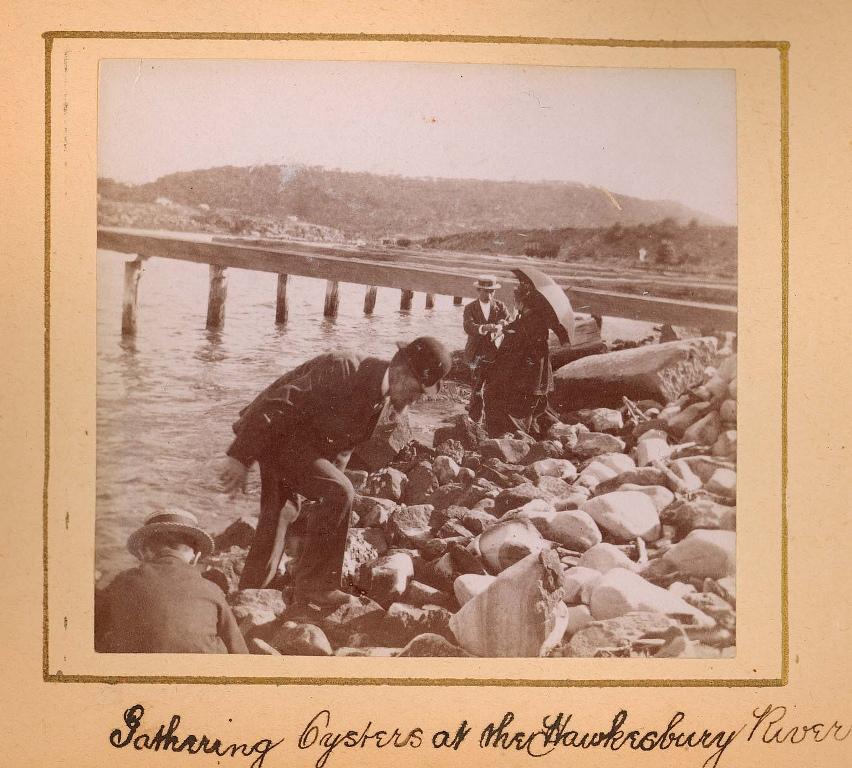
This image is from a leather photograph album dating to the late 1800s (circa 1880). The album contains sepia prints of a voyage from Melbourne to Sydney on SS ARAMAC as well as various sights around Sydney Harbour and the Hawkesbury River. The provenance of the album and the identity of the photographer is unknown. - from the collection of and courtesy of the Australian National Maritime Museum: Object number 00036455_25
There is also some indication in this December 1880 mention of ongoing disputes between George Sly and James Wheeler that people were beginning to realise that the lagoon can, with so many fishing with large nets, be reduced of fish as a resource for catching and move past a point of recovery for fish abundance in future seasons too. Lagoons, the nurseries of so many aquatic crustaceans, molluscs and fish, are vital for all they are connected to.
The shift towards commercialisation also meant the beds were placed off limits to people who lived here or who may have holidayed in the area or came here as excursionists to fish and 'oyster', as shown in many of the old articles we've run on steamers visiting the area where the mention of 'parties fishing successfully' frequently appears. At Narrabeen the resource had been reduced so much bans were put in place and renewed annually:
Oysters. — For the term of one year from the date hereof the natural oyster beds in the Narrabeen Lagoon, county of Cumberland, are closed. Government Gazette. (1879, May 24). The Sydney Mail and New South Wales Advertiser (NSW : 1871 - 1912), p. 817. Retrieved from http://nla.gov.au/nla.news-article162808811
OYSTER BEDS.— By proclamation the natural, oyster beds within the Narrabeen Lagoon, county of Cumberland, are closed for the term of one year. Government Gazette. (1880, May 26). Evening News (Sydney, NSW : 1869 - 1931), p. 3. Retrieved from http://nla.gov.au/nla.news-article108733312
On the 19th of April 1881 under the Fisheries Act of 1881 (Act 44 Vic. No.26), the first Commissioners of Fisheries were appointed. These first five Commissioners of Fisheries were William Dalley (QC), Henry Dangar (MP), Alexander Oliver (MA), George Thornton (MLC), and had William Macleay (MLC) as President. The Commissioners advertised in the New South Wales Government Gazette on 29 April 1881 for Inspectors and Assistant Inspectors of Fisheries. Under section 5 of the Fisheries Act, the Governor would appoint Inspectors and other officers on the recommendation of the Commissioners. Police Magistrates and Police officers over the rank of sergeant had the powers and authorities of Inspectors of Fisheries ex officio. These Inspectors and officers were responsible to the Commissioners.These first Commissioners were responsible for the protection, development, and regulation of the public fisheries of New South Wales.
At the end of 1883, the original Commissioners had been replaced and the present Commissioners were James Cox as President, George Want, John Geddes, Edward Ramsay, and Frederick Thomas. The Commissioners’ staff consisted of the following: a Secretary, two Clerks, one messenger, three Inspectors, seven Assistant Inspectors, thirteen Acting Assistant Inspectors, and four boatmen. - Report of the Commissioners of Fisheries for New South Wales on the state of the Fisheries of the Colony, to the 31 December 1883, Appendix D, in Votes and Proceedings of the Legislative Assembly during the session of 1883-4, Vol.11, p.497.
Within a few years of these early skirmishes net fishing in the lagoon was banned:
A correspondent in today's issue refers to the recent prohibition of net-fishing in certain of our lagoons, and advocates the same course being followed with the other coast lagoons. It is very properly pointed out, if the process of netting is allowed to go on, it will only be a few years before we have no fish at all in our lagoons, which is now pretty much the case with Sydney Harbour. With our splendid coast conformation, and the numerous inlets which are the natural breeding-grounds offish, we ought to have one of the best fish markets in the world. We are, however, in the unfortunate condition of having scarcely enough ash for our own consumption, and the chances of having much less than enough are daily growing greater. At one time there were plenty of fish in Port Jackson. The prodigal and reckless manner in which net-fishing was permitted has, however, not left us enough fish there to give the public recreation in angling. Even upon the basis of providing a natural recreation for the public, the inlets of the sea should not be given over to the ruthless invasion of the seine and the "grab-all." Net-fishing, if permitted in the lagoons, will ultimately destroy our fishing grounds. They are, as our correspondent points out, the spawning grounds from which our supplies of fish must come. If there were danger of our cattle or sheep industry being destroyed, we should take prompt measures to stay destruction, but we do not seem altogether willing to adopt vigorous means to arrest the devastation in our fish industry. The prohibition regarding the waters of the Curl Curl, the Deewhy, and Narrabeen lagoons is timely, but it can be extended with great profit to the country. A few years of rigid prohibition might lessen our immediate supply of fish, but it would increase the future growth of the industry enormously- The exhausted rivers and estuaries along the coast would have a chance to recover their natural supply of fish, and the evil already done would be partially alleviated. It is perhaps to be expected that in a young country less precaution would be observed in preventing the waste of resources, but when extra demands are laid upon nature, science and man's ingenuity should step in to play their part. Much could be done to develop our fish industry, and it is to be hoped that the good work is beginning now. The Sydney Morning Herald. (1888, May 22). The Sydney Morning Herald (NSW : 1842 - 1954), p. 6. Retrieved from http://nla.gov.au/nla.news-article13687246
But no one seemed happy with the Commissioners work:
The Fisheries Commission.
In the month of April, 1881, a magnificent and comprehensive Act was passed for " the development and regulation of the fisheries of the colony." This gigantic effort of legislative genius, of course, required amendment. Accordingly, it was altered in 1884 ; again in 1886 ; and again in 1888. Now it is about time for another amendment ; and certain scoffers, are seriously suggesting that the best thing to do with it is to amend it off the face of the earth. For, like a good many other vast undertakings of which we have to boast, it has proved to be a complete failure. The-Act is worked by a board, of course-in this instance the members are called commissioners-a chief inspector and about25 sub-inspectors ; clerks, draughtsmen, boatmen and engineers. Their salaries, with contingent expenses, amount on the Estimates for 1889 to £3811; a very tidy sum, indeed. ' "What the country gets in the way of return is more than doubtful. True, according to the accounts, the revenue for 1889 from this source is estimated at £4000, derived probably from fees and fines. But the economy of spending nearly £6000 to obtain £4000 is not evident-on the surface, at any rate." Still, if the Acts protected the fisheries, there would be some consolation obtainable. Unfortunately they do nothing of the kind. Practical men assert unhesitatingly that large fisheries have been wholly destroyed, oyster beds extirpated, and havoc played generally with the natural products of the waters both at sea and inland. The fishermen who attempt to comply with the requirements of the Acts are discouraged in every way ; and the preserves are poached upon by foreigners, both Greek and Italian, who treat the law and its officers with complete contempt, and therefore go wholly unpunished. There is a close season for fish-from April to September, for instance; but who regards it ?There are specific rules as to the meshes of nets, and the size of fish; but they are generally ignored. Now and again some unfortunate fisherman who has sinned in ignorance is fined; but these are only the exceptions. There are men plying the trade openly who are ruining the remaining fisheries, and defying the whole army of commissioners, inspectors, and the other officials who eat up the £6000 a year. It is, indeed, high time that there was some alteration in the system. Mr.-Frank Farnell proposes to take some action in Parliament; but that only means another Royal Commission. However, it is vain to hope nowadays for practical legislation on this or any other subject. The Fisheries Commission. (1889, May 4). Australian Town and Country Journal (Sydney, NSW : 1870 - 1907), p. 18. Retrieved from http://nla.gov.au/nla.news-article71118123
FISHERIES. — The tidal waters of Manly, Curl Curl, Deewhy, and Narrabeen Lagoons are closed against the use of fishing nets to 30th November next. GOVERNMENT GAZETTE. (1891, June 6). The Sydney Morning Herald (NSW : 1842 - 1954), p. 11. Retrieved from http://nla.gov.au/nla.news-article13827203
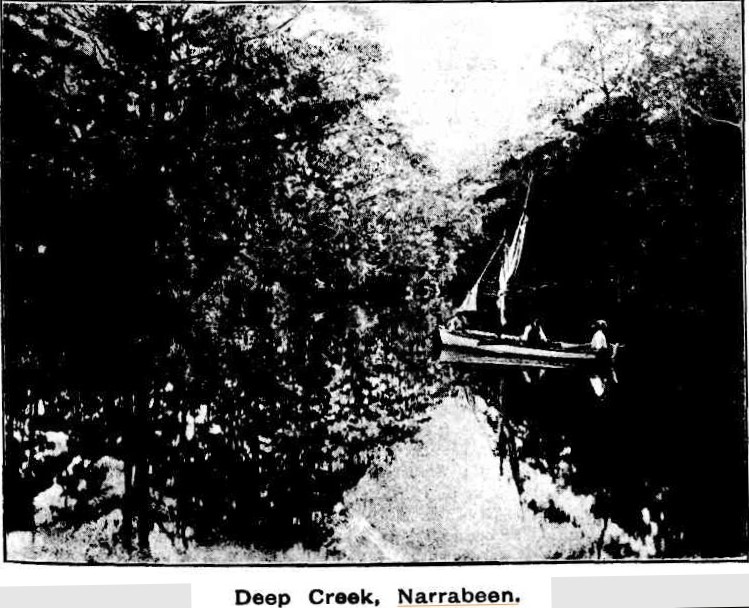
Above: Deep Creek, Narrabeen. Contemporary Journalism. (1893, November 25). Illustrated Sydney News (NSW : 1881 - 1894), p. 15. Retrieved from http://nla.gov.au/nla.news-article63672414 Below:Narrabeen Lakes, No.a116487, courtesy State Library of NSW
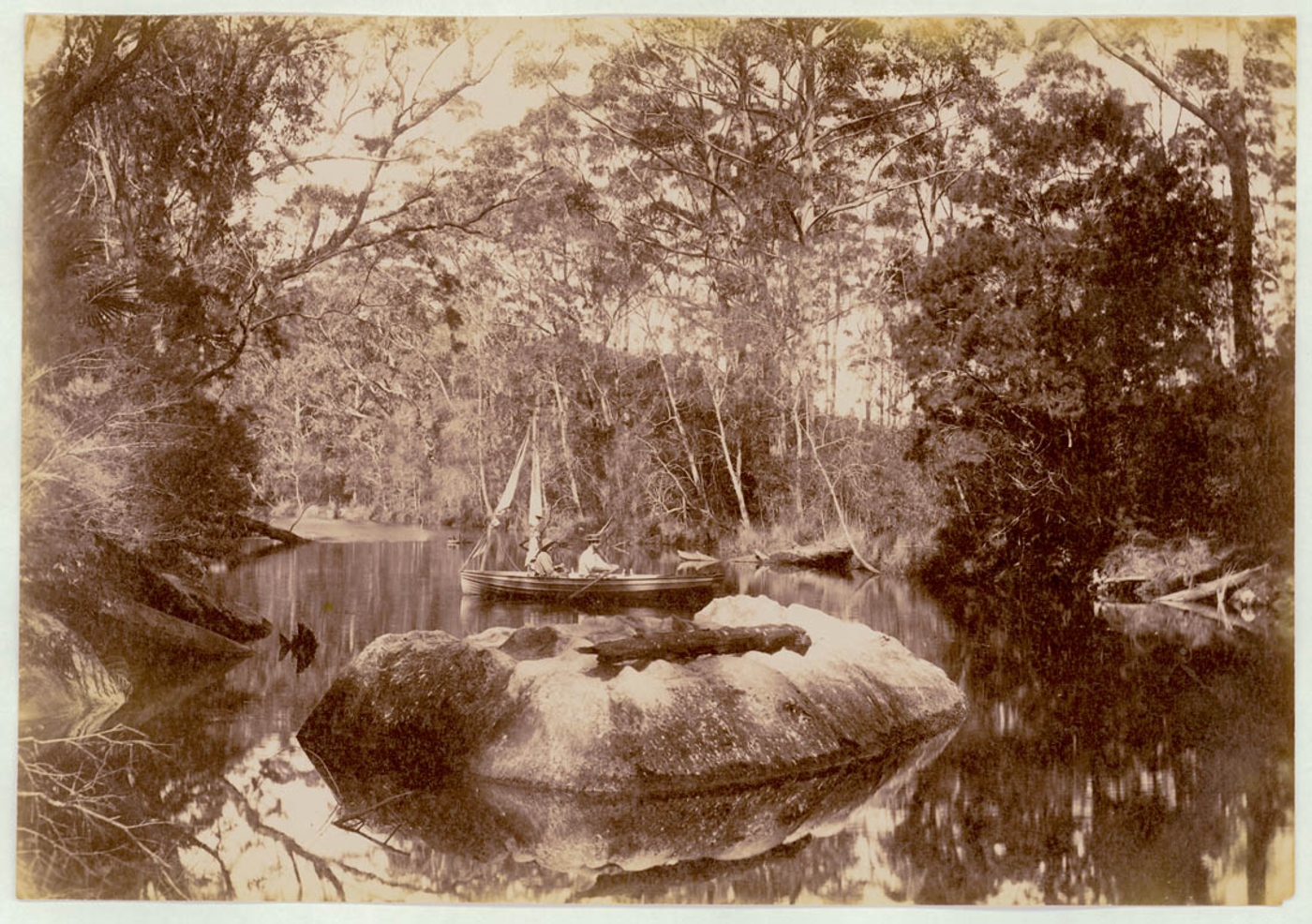
The Macquarie River at Dubbo, and the whole of the tidal waters of Manly, Carl Curl, Deewhy, and Narrabeen Lagoons, together with all bays, affluents, and tributaries, have been closed against net fishing for two years. NEWS OF THE WEEK. (1894, March 3). Australian Town and Country Journal (Sydney, NSW : 1870 - 1907), p. 16. Retrieved from http://nla.gov.au/nla.news-article71210797
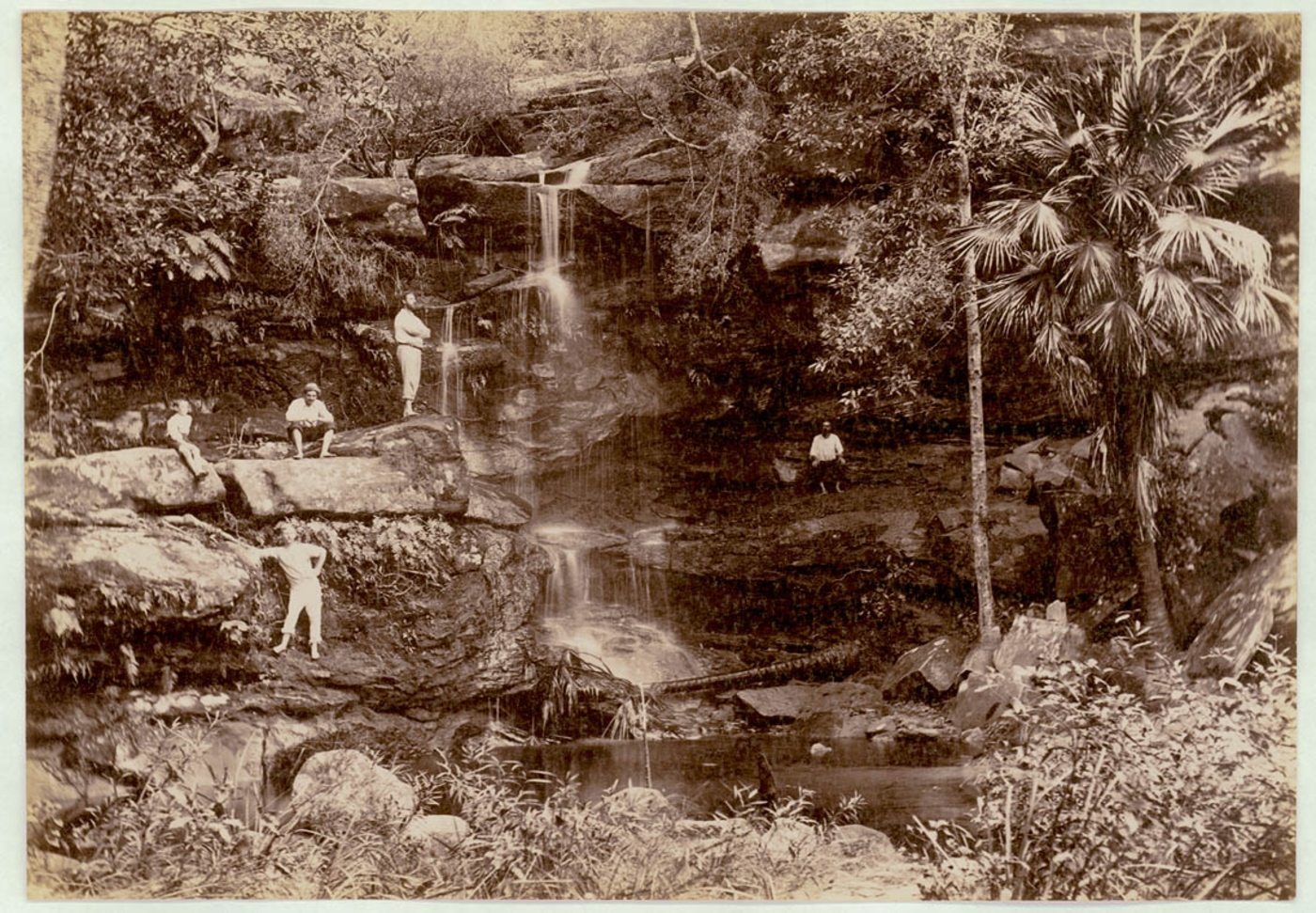
Falls - Narrabeen Lakes - Image: a116484, courtesy State Library of NSW.
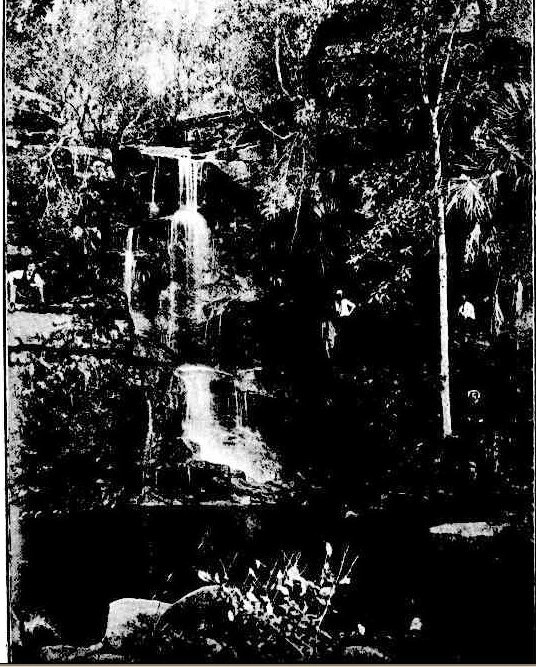
Right: Narrabeen Falls. A Christmas Holiday Trip. (1893, November 25). Illustrated Sydney News (NSW : 1881 - 1894), p. 14. Retrieved from http://nla.gov.au/nla.news-article63104125
It is announced that the whole of the tidal waters of Manly, Curl Curl, Deewhy, and Narrabeen lagoons will be closed against the use of fishing nets for a period of two years from this date. The Sydney Morning Herald. (1897, May 12). The Sydney Morning Herald(NSW : 1842 - 1954), p. 4. Retrieved fromhttp://nla.gov.au/nla.news-article14121040
In 1895 Charles Thackery, a journalist for the Evening News and avid fisherman, known as 'Wobbygong' to acquaintances and friends alike, was instrumental in forming what is regarded as the oldest Fishing Club in Australia who became strong advocates for reforms in regards to protecting our fisheries:
Amateur Anglers. AST ASSOCIATION FORMED.
A meeting of gentlemen interested in the formation of an Amateur Fishing Association was held last evening at Punch's Albion Hotel, Elizabeth-street. The chair was occupied by Mr. W. C. Shipway, M.L.A., and there were about thirty present, all of whom were enthusiastic disciples of the late Isaak Walton. The chairman explained the objects of the meeting, which he said was not only to provide sport for the members of the proposed society, but to protect and develop the fisheries in Port Jackson and its environments, and more especially to prevent the wanton destruction of small fish. Mr. C. Thackeray moved —'That an association, to be called the Amateur Fishing Association of New South 'Wales, be formed, having for its objects the protection of fish, the promotion of good fellowship amongst fishermen, the advancement of the sport of fishing by prize contests, reliable information, and the reduction of expenses in travelling, boat hire* &c, and sundries.' The motion was seconded by Dr. Graham and carried. The following gentlemen were appointed office bearers: Patrons, Messrs. J. H. Carruthers, M.L.A., E. H. D. White, M.L.C., F. Farnell, M.L.A. Dr. Cox, James Marks, and Critchett Walker; president, Mr. W. E. Shipway, M.L.A.; vice presidents, Dr. Graham, M.L.A., Messrs. H.M'Lachlan, and A. Spain; hon secretary, Mr. C. Thackeray; treasurer, Mr. E. L. Maxwell; committee, Messrs. G. L. Goodman, C. B. Jackson, A. Light, Wiseheart, Despointes, Gruning, Thynne,' Torr, and C. B. Rodin. It was decided that the subscription should be 5s per annum, and that another meeting should be held on Friday next, when the committee would bring up rules and regulations. Trophies were promised by Mr. Shipway, Messrs. Mason and Company, and Mr. Despointes. Amateur Anglers. (1895, January 26). Evening News (Sydney, NSW : 1869 - 1931), p. 3. Retrieved from http://nla.gov.au/nla.news-article108071172
In 1896 the 'Royal Commission' into fishing and fisheries tabled a report and a move towards a Fisheries act began:
The Fisheries Bill.—A deputation from the Narrabeen Progress Association was introduced by Mr. D. Thomson, M.L.A., to Mr. Wood, Minister for Justice, yesterday, in the absence of the Colonial Secretary, with reference to the Fisheries Bill. The object of the deputation was to press upon the Government the necessity of proceeding with the bill now before Parliament. It was stated that great injury was being done to the lakes at Narrabeen by their being denuded of fish. At present the mouth of the lake was blocked, but one fisherman, at a single haul, had taken out 36 baskets of fish (about a ton), and if this kind of thing was continued the supply would soon become exhausted. The lakes ought to form a natural nursery for the fish, and netting should be prohibited. The commissioners had no power to close any place against net fishing unless they were satisfied that the waters had been denuded of their natural supply of fish. It was stated that the Amateur Fishermen's Association, which had previously been opposed to the bill, had now withdrawn its opposition and was in hearty accord with the objects of the deputation. In reply, Mr. Wood expressed pleasure at the unanimity of opinion respecting the bill, and stated that Mr. See had informed him that if the state of public business permitted the Government would go on with and endeavour to pass it into law this session. THE SOUTH AUSTRALIAN WINE DEPOT. (1900, October 30).The Sydney Morning Herald (NSW : 1842 - 1954), p. 4. Retrieved from http://nla.gov.au/nla.news-article14377911
Meanwhile at Narrabeen - another long-time resident seemed to be objecting to the influx of recreational fishing sportsmen:
NARRABEEN LAGOON.
Some time ago the Amateur fishermen's association drew the attention of the Minister for Lands to the fact that the southern foreshore of Narrabeen lagoon, in the district between Manly and Newport, was no longer traversable by pedestrians, even at the high tide limit. It was pointed out that the waters of the lagoon were practically tidal, as they periodically broke through to the ocean, or the ocean waves beat through into the lagoon; that the place was a valuable coastal nursery for marine fish; that the public had access to the lagoon for 50 years until quite recently, when fences with barbed wire on them were placed along the old path, and that the alienation of the foreshore would be detrimental to the interests of the public. The Minister (the Hon. W. P. Crick) caused inquiries to be made, and as a result the association has received the following letter -:
"Referring to your letter of April 22 last, protesting against the sale of the southern foreshore of Narrabeen lagoon, I am directed to inform you that by a recent investigation of the tidal limits of the lagoon it is found that the frontage thereto is encroached upon by fencing. The limit line has been defined and adopted, and Mr M'Intosh has been notified to remove his fencing accordingly, i.e., to the defined line. (Signed) H. CURRY, Under-Secretary."
The president of the association (Captain A. Spain) has despatched a letter of thanks to the Minister, pointing out that the step decided upon will result in increased traffic to Narrabeen. NARRABEEN LAGOON. (1901, August 23). The Sydney Morning Herald (NSW : 1842 - 1954), p. 5. Retrieved from http://nla.gov.au/nla.news-article14405124
Narrabeen Lake is open to the ocean, and the sport near the entrance on the beach is said to be good. It usually is In mild weather. Jewfish black bream, and whiting are the principal fish taken on the ocean beach, while in the lakelet small whiting, mullet of two kinds, black bream, and flathead are to be caught. There is an opening for a good boatshed at Narrabeen if the place is kept closed to netting.Garfish are often taken In great numbers off the bridge. The tram will run to Narrabeen before two years are gone, and cyclists are already giving the lake a trial! FISHING NOTES. (1901, September 4). Referee (Sydney, NSW : 1886 - 1939), p. 2. Retrieved fromhttp://nla.gov.au/nla.news-article120645481
It was actually over another ten years before the tram line to Narrabeen was opened.
The list of places closed against net fishing Is as follows: — Lake Macquarie, closed until February 21, 1903 ; Tuggerah Lakes channel entrance and portions of Budgewoland Munmorah Lakes, until June 13, W02 ;. Brisbane Water, above the Rip, including the fishing grounds of Woy Woy, Broadwater, and Gosford, until November 16, 1902 ; Port Jackson, south-cast of Grotto Point and Middle Head (exclusive of the Pearl bay flats and the main arm above Echo Farm, which are open to netting), and southerly from a line drawn from Middle Head to Shark Point, until October 15, 1902; Lake Illawarra channel entrance and the mouth of Mullet Creek, until October 25,1902 ; Narrabeen, Deewhy, Curl Curl, and Manly lagoons, until April 23, 1903; FISHING NOTES. (1902, June 11). Referee (Sydney, NSW : 1886 - 1939), p. 9. Retrieved from http://nla.gov.au/nla.news-article120119222
Introduced in 1902 and assented to on December 29th, the Fisheries Act finally came into force on February 27th, 1903:
FISHERIES ACT.
The new Fisheries Act came into force yesterday. The principal provisions, briefly, are that: 'Persons fishing for sale, or using a boat for that purpose, must take out a licence, costing 5s,for the year. For every person selling oysters, wholesale or retail, the fee is 20s per annum. This cause is very far-reaching, as oyster lessees, keepers of oyster shops, hotel-keepers, restaurants, persons selling oysters in bottles, and oyster hawkers, will all require licences. Licences may be obtained at the Treasury, and from clerks of petty sessions in the country districts. Fishing nets must not be landed on shore in such a manner as to prevent under-sized fish, from escaping. It is unlawful for fish to be left on the shore. The inspectors of fisheries may seize sll undersized fish, and persons who are found with such fish in their boats, or on their Premises, or in their possession, are liable to a penalty of £2. The schedule weights at which fish may be taken are as follow: — Red and blackbream:, blackfish, rock cod, mullet, whiting, salmon, and carp, 6oz; tarwhine, 7oz; gurnet, flounder, =;oz, pike, trevally, nannagai, and sergeant baker, 4oz; flathead and long torn, 5oz; garfish, pilchard, and herrings, 2oz; trout, traglin, and groper, 12oz; 'John dory, pigfish, perch, and eels, 8oz: kingfish, jewfish, and morwhong, 10oz; Murray cod. 24oz; crayfish, 10in long; prawns; 1 ½ inches;fresh water lobsters, 8in; the measurements to be taken from the eye to the tip of the tail. Trout may only be taken with a rod and line. It is illegal to use a night line, net, or fixed engine for catching trout. No oysters may be taken from unleased Crown lands or public oyster reserves, but the public may consume as many as they like on the waters or foreshores.' FISHERIES ACT. (1903, February 28). Evening News (Sydney, NSW : 1869 - 1931), p. 6. Retrieved from http://nla.gov.au/nla.news-article113396603
FISHERIES COMMISSION. The newly-appointed Fisheries Commission met for the first time yesterday, Mr. Farnell, M.L.A. (chairman) presiding. All the members, except Mr. J. H. Want, M.L.C., who is travellingabroad, were present. Prior to the business of the meeting being entered into, Dr. Cox, who was president of the old board, congratulated Mr. Farnell on his appointment, and added that he was thoroughly entitled to it, in view of the work he had done for the fisheries. The regulations under the new Act were submitted by the secretary and chief inspector (Mr.J. A. Brodie). Their consideration was deferred for a week, as was the matter of the description of nets for various waters. It was decided not to appoint a deputy chairman. Should the chairman be absent, the meeting will select its chairman. A form for the weekly return from the markets, as laid down in the Act, was approved. Several requests were made to have the weights of fish in the schedule reduced. This matter was deferred, the board being of opinion that some should be reduced and others increased. Brisbane Water is now closed to nets by the Act. The board, however, gave a fisherman residing there permission to go to and from his home with, a net in his boat. Otherwise this mere act would carry a penalty. The question was raised as to whether restaurants and clubs, which included oysters in their bills of fare, should be required to have a licence for selling them. The board decided in the affirmative.Several applications were made to collect spat at Cowan Creek and Port Hacking for stocking oyster leases. This matter was also deferred, pending the framing of the regulations. It was decided to ask the Harbours and Rivers Branch if oyster leases would be granted to responsible persons for the training walls on the northern rivers. At present the public can take the oysters, and the board held the opinion that the walls would be better safeguarded if the leases were issued. It was decided to issue summonses for the recovery of £97 arrears of rent on oyster leases. It was resolved to close all the rivers in New South Wales, their tributaries and affluents, from the taking of trout by any means from April 1 to August 31 (the spawning season). Several cases of taking undersized fish had been reported, and it was decided to caution the persons concerned. The board will in future meet each Tuesday' at 4 o'clock.FISHERIES COMMISSION. (1903, March 31). Evening News(Sydney, NSW : 1869 - 1931), p. 3. Retrieved fromhttp://nla.gov.au/nla.news-article113399799
FISHERY MATTERS.
A report was recently received from Queanbeyan to the effect that a number of fish had died from poisoning in the Queanbeyan and Molonglo Rivers. It was thought, locally, that the fish had succumbed to the effects of phosphorus contained in the rabbit baits which the heavy rains had washed into the rivers. The Fisheries Board called for a report from the local police, who stated that there had been heavy rains, and as a result a lot of filthy matter, such as the debris from sheep camps, had been washed into the rivers. A number of cod had been affected, and floated on the surface of the water. When taken out by residents, and immersed in clean water, they recovered, and were eaten without ill effect to those of who partook of them. This established the fact that the condition of the fish was not due to the phosphorus. 'It is a common thing,' said Mr. Brodie (the Chief Inspector of Fisheries) to an 'Evening News' reporter, 'to find fish affected by floods. The impure water enters the gills, and the fish suffocate.'
Great activity is being shown by fishermen in taking out licences under the new Act. For the first three months of 1903 1288 fishermen's licences were issued, as against 681 in the same period of 1902, and 638 boat licences, as against 290 in1902. The increase is more marked when it is explained that during the whole of 1902 only 943 fishermen's licences were issued, and 441 boat licences. In 1902 the fee was-£l per boat, and 10s per man; now the amount is 5s in each case. Since February 27, 1903, 176 oyster vendors' licences have been granted. It is pointed out by the department that any water closed to fishing is also closed to prawn nets. All persons selling oysters whether in restaurants or on railway platforms, must take out a licence. One of the fishery inspectors, Mr. Brodie states, has dropped upon a person using a net at Narrabeen Lagoon. This water was declared to be closed for two years, and the time has not yet expired. All Sydney Harbour is open to net-fishing. FISHERY MATTERS. (1903, April 4). Evening News(Sydney, NSW : 1869 - 1931), p. 6. Retrieved from http://nla.gov.au/nla.news-article113419232
The moratorium on netting, professional fishing and prawning, in Narrabeen Lagoon continued with occasional lapses that brought some humorous insights, and evidence that letting the waters replenish themselves was working, when the waters were there of course:
NARRABEEN LAKE.— A few sportsmen have been catching flathead in the upper part of the lake bed, which contains some water yet.The bulk of the lake was dry until recently. The rains of this week may make some difference. FISHING RESORTS. (1905, March 5).Sunday Times (Sydney, NSW : 1895 - 1930), p. 8. Retrieved from http://nla.gov.au/nla.news-article125861413
PRAWNING AT NARRABEEN.
Many visitors to Narrabeen have been catching prawns for food and bait lately by means of small landing nets of fine mesh. The scene at night recently was a moist interesting one everybody out for the crustacean had a light and the movement of these about the lake made a picturesque scene at the rate at which parties were operating it would take about a month to clear all the prawns out of the shallow and easily accessible water, but reasonable methods of working would make the pastime and the supply last a good deal longer. One party with a desire to bag more than anybody else used a large net variously stated to be from; 10ft to 20ft long for prawning, and gave nobody else chance at the prawns near where they worked It is advisable to point out that the use of this net is in offence against the fisheries regulations as Narrabeen Lake is closed to netting of all kinds. Even the small hand nets are illegal, but no Fisheries inspector would seek to enforce the law against the users of these. For the purpose of teaching the users of the long net in the lake that they cannot take more than their neighbours, it would be well if the inspector made an example.
Prawns are active and curious creatures, but they become very cunning after they have been pursued two or three times. They will watch the approach of the net and dodge back from it, or jump over it out of the water and they are also provided with means for impressing their dislike for human hands in the form of strong spines. Several people round the lake bear evidences of the spinious attentions of the prawns, but thev are consoling themselves with the reflection that the crustaceans in the pot were far superior to the basket-men's supplies. To get the best culinary results from simple billing, the prawns should be put into pot of sea water and cooked for ten minutes after the water has reached boiling point, and all the scum that rises should be skimmed off. It may be added that this occupation may be engaged in at Tuggerah, Lake Macquarie, Deewhy, Illawarra, and all the other coastal lakes, and visitors to those places should go prepared. ANGLING. (1909, January 2). The Sydney Morning Herald(NSW : 1842 - 1954), p. 15. Retrieved fromhttp://nla.gov.au/nla.news-article15002510
A Valuable Prawn Fishery.-Mr. H. Fanning, one of the members of the Fisheries Board, sought yesterday to induce the board to re-open Narrabeen Lake to prawning during the summer. He submitted a statement by letter to the effect that the value of the prawns netted in the lake during 1907 was £565, and he gave the names of those who had participated in the hauls. But Mr. Fanning received a shock when the secretary of the department, Mr. J. A. Brodie, pointed out that two of the names given as amongst the principal sharers in the wealth of the lake were not the holders of Fishing licenses during 1907. Mr. Fanning subsided, and the board decided to secure further information, possibly with a view to the prosecution or those who had netted without a license. The lake last year yielded a moderate quantity of prawns to amateur parties, who used small hand scoop-nets to secure the crustaceans, but towards the close of the summer hardly a prawn could be caught, and It was the opinion of many who live near the lake or who visit it for week-ends that the supply had been greatly reduced. INTERSTATE PRODUCE TRADE. (1909, August 24). The Sydney Morning Herald (NSW : 1842 - 1954), p. 6. Retrieved from http://nla.gov.au/nla.news-article15093684
Remarkable Scene. When the waters of the Narrabeen Lake were opened to the sea on Sunday by volunteer workers and the men of the local shire council, some remarkable scenes were witnessed. There was an immense volume of water in the lake, and when the channel was cut with shovels the outrush of water tore a wider channel along which thousands of fish were hurried to the sea. Many mullet about 18 inches long leaped high out of the water as they neared the spray of the waves of the ocean beach, their object being to avoid the attacks of huge tailer, which were waiting for them outside the bar. The tailer came right up into the wave roll to take the fish from the lake, and snapped viciously at their prey. Men rushed into the current and threw hundreds of fish out on to the sand with prawn nets and their hands. One sportsman grabbed a mullet at the same time as a tailor, and each got half the fish. Another man had a tailer seize his coat, and he emerged from the channel with the fish hanging to it Whiting proved the most elusive fish to catch, but the mullet wore bewildered, and were easily secured with the hand by hundreds of people on the lake beach and in the channel entrance. MINES AND RAILWAYS. (1910, March 15). The Sydney Morning Herald (NSW : 1842 - 1954), p. 6. Retrieved fromhttp://nla.gov.au/nla.news-article15153991
NARRABEEN LAKE.
Two deputations waited upon the New South Wales Fisheries Board, at its fortnightly meeting yesterday. The first, that of fisher-men of the district, introduced by Mr. Faning (the fishermen's representative on the board), comprising Messrs. H. Mawdsley, N. S. Graham, C. Hirsch, F. Francis, S. C. Twight, F. W. Casy, F. W. Barrett, J. Nel son, asked that Narrabeen Lake, which is closed to netting until April 27, 1911, be opened. The other deputation, which opposed the opening of the lake to netting, was introduced by Dr. Arthur, M.L.A., and consisted of Councillors E. W. Quirk and Powell (Warin-gah Shire), Messrs. H. Gordon (president Narrabeen Progress Association), D. M'Lean, C.C. Marshall, R. Marshall (district residents),and C. Thackeray (president Amateur Fishermen's Association).Messrs. Twight, H. Mawdsley, and C. Hirsch spoke on behalf of opening- the lake; and Dr.Arthur, Councillor Quirk, and Mr. C. Thack-eray advocated that the closure be kept up as previously gazetted. The chairman (Mr. F.Farnell) said that the board would again duly consider what had been, said on both sides of the question, and would give its decision at its next meeting. NARRABEEN LAKE. (1910, April 6). Evening News (Sydney, NSW : 1869 - 1931), p. 3. Retrieved from http://nla.gov.au/nla.news-article115240351
Despite the above report showing a return to fish in the Narrabeen lagoon, large scale net fishing was still prohibited and the ban was renewed prior to expiring annually. Campers and residents could still use hand nets to go prawning, and did:
NET FISHING AT NARRABEEN LAGOON. The Acting Chief Secretary, Mr. Flowers, who has had the matter under consideration, has decided that the waters of Narrabeen Lagoon shall be closed against net fishing for a further period of six months from 27th instant, on which date the existing prohibition against net fishing expires. The Narrabeen Progress Association has strongly urged that the Lagoon be kept closed against net fishing. NET FISHING AT NARRABEEN LAGOON. (1911, April 11).Evening News (Sydney, NSW : 1869 - 1931), p. 11. Retrieved from http://nla.gov.au/nla.news-article114129113
NARRABEEN LAKES. WORKS DEPARTMENT'S SCHEME AGREED TO. A special meeting of the Warringah Shire Council was held to consider the proposed scheme by the Works Department for improving the Narrabeen lakes. The proposal is to cut a channel in the rock at the foot of Narrabeen head from the ocean into the lake, through which the tide will flow. Councillor Quirk moved that the Minister for Works be informed that the Council is prepared to guarantee the following-"To Carry out the work of constructing an opening on the lines of the plan and specifications submitted, 18ft wide at a cost of £580 that the council guarantee to put the work in hand immediately the work of constructing the tram Is commenced which will allow it to be completed some months before the tram reaches Narrabeen and that a sufficient number of boats will be provided at four different points on the lake.” The motion was unanimously agreed to. NARRABEEN LAKES. (1911, May 11). The Sydney Morning Herald (NSW : 1842 - 1954), p. 3. Retrieved fromhttp://nla.gov.au/nla.news-article15239491
WHEREAS the Minister charged with the administration of the Fisheries Acts has advised that, for the more effectual conservation of the fish supply, and for the protection of the spawning and feeding grounds of Immature fish, it is desirable that the waters of DEEP CREEK, MIDDLE CREEK, and SOUTH CREEK tributaries of NARRABEEN LAKE, should be closed against the use of Fishing Nets: Now, therefore, I, FREDERIC JOHN NAPIER, BARON CHELMSFORD, in pursuance of the provisions of Section 12 of the Fisheries Act. 1902, with the advice of the Executive Council, do, by this my Proclamation, declare that the waters of the said Creeks upwards from their points of entrance to the said Lake, shall be closed against the use of Fishing Nets for a period of five years from the 23rd April instant Inclusive. Given under my hand and seal at Sydney this twenty-third day of April, In the year of our Lord one thousand nine hundred and twelve, and in the second year of his Majesty's reign. By his Excellency's Command. _ FRED. FLOWERS. GOD SAVE THE KING. Advertising. (1912, April 26). The Sydney Morning Herald (NSW : 1842 - 1954), p. 13. Retrieved from http://nla.gov.au/nla.news-article15327259
NARRABEEN AND DEEWHY. Between Manly and Pittwater and comparatively close to Sydney are the two saltwater lakes of Deewhy and Narrabeen. Both are rich in prawns in summer time, and the scene at night on Narrabeen, when hundreds of people, clad in Swimming costume, and carrying hand-nets and lights, seek the delicious crustaceans, is a striking one. Deewhy is the haunt of black swans and Is very shallow. Narrabeen Is narrow at its lower end, but widens out into a fine sheet of water a mile above the bar, which is frequently opened either by man or the ocean waves, so that the sea water has free access with the tide. Plenty of fish are caught in the lake, and on the ocean beach and rocks, and surfers and "sun-bakers" spend many enjoyable hours on the long sweep of clean, white sand, and in the tumbling waves which wash It Deep, South, and Middle creeks are three beauty spots of Narrabeen. Just off the placid mirror-like waters of Deep Creek are two small but picturesque waterfalls. Narrabeen is reached by boat to Manly and thence by tram at a cost of 9d. Little wonder therefore that It is a popular resort for thousands of people during eight months of the year. With Rod and Line. (1912, September 24). The Sydney Morning Herald (NSW : 1842 - 1954), p. 9. Retrieved fromhttp://nla.gov.au/nla.news-article15363330
PRAWNING AT NARRABEEN.
(BY G. M.)
The lake at last. Those swords of ruddy light which I perceived through a clearing in the timber were doubtless reflections upon its dark, mysterious surface which was betrayed by no silvery shimmer borrowed from the big stars in the west. Whence those reflections proceeded one could only surmise, probably from camp fires or lighted bungalows on the farther shore; maybe some of them were the lights of fishing boat. The week-end cottages were now very much in evidence. A cheerful stream of light proceeding from an open doorway reminded me that I might at last inquire the way to the particular cottage I had rented. Stepping on to the verandah, a rather curious sight met my momentarily astonished gaze and as I knocked I smiled at the thought of how some staid, un-experienced Englishman would be staggered at the way Australians sometimes dress (or undress) for dinner. Assuredly at a first glance he would never have taken the half dozen young fellows who sat at the table for members of the Anglo-Saxon race. Brown as South Sea Islanders and just as scantily clothed, they sat there eating their meal in all the happy abandon of bare, brown, muscular limbs. Their swimming costumes were their sole covering. The gentleman officiating as cook was imbued with a clear appreciation of economy of effort, for he moved silently round the festive board and emptied the panful of hot fish directly on to the waiting plates. When he came to the door the utensil still in his hand, and answered my inquiries, I perceived from his features and his courteous, educated accents, that he was not a kanaka after all (some days later I found that the occupants of the place were all medical students).
My cottage was situated on an embankment that shelved abruptly to the edge of the lake. To the north-west a great pyramidal hill uplifted itself - grim, abrupt, and distinct - out of the gloom that shrouded its base. The lake showed dimly beneath me; it seemed to occupy a vast hollow, and its waters possessed a strange suggestion of expansiveness and depth. Its surface was resplendent with a score of moving lights, a beautiful, but at the same time a rather puzzling constellation. What were they? Away in the distance they gleamed fitfully disappeared and then shone forth again in queer will-o-the-wisp fashion.
Nearer the shore they showed brightly, moving in erratic systemless manner. Sometimes one would suffer an eclipse, but what the Intervening bulk was I could not tell. Sometimes a beam would describe a great arc across the water, and remain focussed like a miniature searchlight in a northerly direction. A number of boats each equipped with a stern light, and abandoned to a capricious, intricate current, might have been responsible for that strange phenomenon, but not a ripple disturbed the mysterious waters. A light moved shorewards. Gradually an ever-widening halo emanated from the glowing central nucleus and in that halo I distinguished moving things. Explanation at last. It was a hurricane lamp held aloft by mortal hand, and presently mortal legs came splashing through - alas, barely two foot of water. It was with regret I learned my mysterious lake was fathomable after all. The lantern-bearer came nearer, and it was plain that others were with him, dim figures clad in swimming costumes, who preserved an utter silence. Something swished through the water; the light stopped moving, a dripping object was held up to the glare for inspection - a prawning net. Thus did the true explanation of Narrabeen's Venetian scene come home tome. Those lights all belonged to parties that pursued the elusive and appetizing prawn. The Illuminations reveal the presence of the shrimp and the nets do the rest.
This party's expedition was over. They stepped ashore, the lantern-bearer bringing up the rear, and moved up the slope to the neighbouring cottage. It was a family party, father, mother, and four sturdy youngsters. It was nearly midnight when the last lantern disappeared. Well, it had been a picturesque scene all right, but I was convinced they were lunatics who had provided the spectacle. I modified this latter opinion somewhat before I left Narrabeen, though the persecuted prawn never suffered from my personal attentions(the deep upper reaches of the lake abounded in good flathead, and that satisfied me).
After a few days I came to the conclusion that people go to Narrabeen to prawn. Incidentally they go there to fish and to swim, and to "sunbake," but the nocturnal pursuit of the prawn is the prime attraction. The forward end of the lake is uniformally shallow. Cosy bungalows nestle by the water's edge, and the use of a boat generally goes with the lease of one of these residences. In the dusk of the evening you will see whole families leave the bungalows and proceed to the water. They carry the inevitable lantern and prawning net, and, as a rule, they are garbed in nothing but their swimming costumes. Nobody seems to fear catching cold, and, stranger still, nobody does catch cold. Frequently one member of a party will row a boat behind the prawners, who wade along. The boat's function is to provide a receptacle for the "catch". Then, as the gloom of a moonless night settles over the lake, the lanterns shine forth one by one, giv-ing the water the picturesque effect I have desribed. Prawning is a silent, decorous pastime.
My neighbour, a serious-minded, middle aged business man, repeatedly tried to induce me to join these excursions, but I always declined. He asserted that prawning was an exhilarating, healthy pastime, that people who laugh at the ridiculousness of the thing ultimately derive an exquisite pleasure from pursuing the nimble shrimp; these, and other arguments, he put forward, but in vain. I do not know the pleasure of prawning; I don't understand the philosophy of prawning, nor the psychology of prawning. I only describe what I saw, and make a final observation that people appear to enjoy the business and come to no harm thereby. But Narrabeen provides quite a multitude of varied pleasures. And now, as I sit on my balcony, and watch the mystic, moonlit waters(the prawners are few to-night) winding away to those grim western hills, and listen to the myriad voices of the ocean, I know that the place is beautiful, and that here the Jaded city may find contentment and rest. PRAWNING AT NARRABEEN. (1913, February 1). The Sydney Morning Herald (NSW : 1842 - 1954), p. 27. Retrieved from http://nla.gov.au/nla.news-article15394551
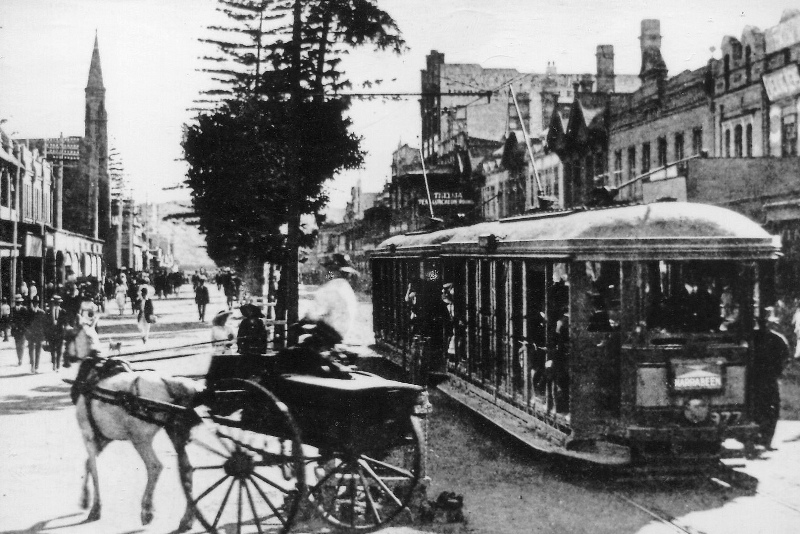
Above: The Tram to Narrabeen on Manly Corso
NARRABEEN TRAM. Commencing Monday next, the extension of tram line from Collaroy Beach to Narrabeen will be opened for traffic, and a regular service of trams will be run daily between Manly Pier and Narrabeen, connecting with steamers to and from Circular Quay. NARRABEEN TRAM. (1913, December 6). The Sydney Morning Herald (NSW : 1842 - 1954), p. 22. Retrieved fromhttp://nla.gov.au/nla.news-article28121325
The opening of the Tram line brought thousands of people to Narrabeen. More in: Tram Memorabilia - Historic Daylight Run For Sydney Light Rail Begins 80 Years After Last Tram To Narrabeen Closed
The influx, along with historical 'catches' saw new measures introduced to help the local lagoon inhabitants recover:
GOVERNMENT NOTICES - PROCLAMATION - NEW SOUTH WALES, to wit.-By HIS Excellency Sir GERALD STRICKLAND, Count della Catena, Knight Grand Cross of the Most Distinguished Order of Saint Michael and Saint George, Governor of the State of New South Wales and its Dependencies, in the Commonwealth of Australia. G. STRICKLAND (L.S.), Governor.
WHEREAS, under and by virtue of the Fisheries Act, 1902, power is given to and vested in the Governor of the State of New South Wales, with the advice of the Executive Council thereof, from time to time, by Proclamation in the Gazette, to declare (interelia) what length of net and wire of mesh for the whole or any part of a fishing net, when used or Intended to be used in any specified water or waters for catching any specified kind or kinds of fish, shall be a lawful net: Now, therefore, I, Sir GERALD !STRICKLAND, Count della Catena, the Governor of the said State, in pursuance of the provisions of the said Fisheries Act, 1902, and of any other power me thereunto enabling, with the advice of the Executive Council of the said State, do, by this my Proclamation, declare that with respect to fishing nets, known as "meshing-nets," to be used in the waters specified in the appended Locality Schedule)for the purpose of catching all kinds of fish during the months of April and May in the years 1915 and 1916, a net with the length of net and size of mesh set out in the Schedule hereto shall be a lawful net, and no other meshing-net and no hauling-net of any dimensions whatsoever shall be a lawful net.
Given under my Hand and Seal, of Sydney, this second day of July, in the year of our Lord one thousand nine hundred and fourteen, and in the fifth year of His Majesty's Reign.
By His Excellency's Command, J. H. CANN. GOD SAVE THE KING.
The Schedule. Total length of net not exceeding one hundred fathoms, of which not more than fifty fathoms shall save a mesh of not less than three inches, and the remainder a mesh of not less than four inches. Locality Schedule. County of Cumberland, parishes of Narrabeen and Manly Cove. The whole of the waters of Narrabeen Lake. Advertising. (1914, July 18). The Sydney Morning Herald(NSW : 1842 - 1954), p. 14. Retrieved from http://nla.gov.au/nla.news-article28115948
A few seasons later there seems to be evidence that Narrabeen Lagoon is recovering and that the prawns, at the time of year they are meant to be abundant, were so:
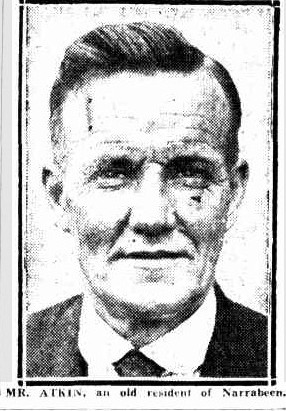 Tons of Prawns - NARRABEEN HAUL Millions Swept to Sea.
Tons of Prawns - NARRABEEN HAUL Millions Swept to Sea.
If prawns would keep, holidayers at Narrabeen would have them for tea for weeks. Last night the sand blocking the sea entrance to the lagoon was cut away to allow the surplus rain water to flow out – and with it moved the prawns – millions of them. About 200 people gathered at the entrance, and took away as many prawns as they could carry. They put them in kerosene tins and chaff bags and even took off their shirts and tied the arms and the necks up. But even with all these emergencies the crowd could not get a quarter of the prawns as they were washed past the entrance. Tons of them went straight out to sea.
“I’ve been living here for 16 years.” said the local news agent, Mr. E. N. Atkin, today, 'but I've never seen anything like last night. The prawns simply swept along In millions. There are always plenty of prawns In the lagoon, but I've never seen as many in 16 years as I saw last night.' The reason for cutting away the entrance, of course, was that the lagoon, after the heavy rains, was beginning to overflow in Inland parts. So the council thought It wise to let the surplus water run away. But with that surplus water went tons of prawns— straight out into the Pacific. Tons of Prawns. (1922, January 4). Evening News (Sydney, NSW : 1869 - 1931), p. 6. Retrieved from http://nla.gov.au/nla.news-article118872236
Picture at right from: Mr Atkin – an old resident of Narrabeen No title. (1925, February 1). Sunday Times (Sydney, NSW : 1895 - 1930), p. 7 Section: Social and Magazine Section. Retrieved from http://nla.gov.au/nla.news-article128164071
NARRABEEN. Mr. T. le Clerc, jun., fishing at Narrabeen recently, caught a jewfish about 20lb weight and a few large tailer. Beach anglers who desire to catch tailer should fish the gutters at night and have their hooks wire-snooded. The chop of a tailer's teeth is not as sudden as that of a leather-Jacket, and many tailer are landed on twisted gut snoods on long-shanked hooks ; but there is a bit of luck about the process. If the fish gets the bait right down in its throat at its first rush, anything except wire is likely to be cut by its sharp teeth.
Narrabeen Lake is open to the sea, and ocean fish should enter it freely on the night floodtide.
Once whiting, flathead, tailed, gar, mullet, bream, blackfish, and tarwhine get into this safe little feeding water, which is free from sharks, they stay in it and grow quickly.
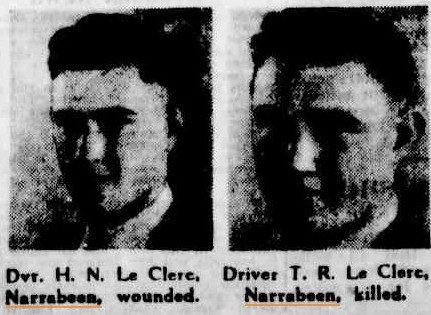 As a prawn-breeding marine lake, Narrabeen, for its size, has few equals as a fishery. It is at present closed to all kinds of netting, and local residents should see to It that the closure is observed.
As a prawn-breeding marine lake, Narrabeen, for its size, has few equals as a fishery. It is at present closed to all kinds of netting, and local residents should see to It that the closure is observed.
At Fairy Bower, Manly, the other day, a lobster pot set for crayfish was found to contain a wobbegong 4ft 10in long. The aperture in the trap by which it entered was only 10 ½ in across, and there was not much room inside; but the mottled visitor with its fringed jaws easily curled up inside. Of course, it could not get out without assistance and the opening of the trap. NARRABEEN. (1922, October 1). Sunday Times (Sydney, NSW : 1895 - 1930), p. 10. Retrieved from http://nla.gov.au/nla.news-article128209193
It is wonderful to see that a young Thomas Robert Arthur Le Clerc thrived in pristine Narrabeen Lagoon, and would have had many great and memorable Springs and Summers, as he was killed serving his country in Crete, Greece, on May 21st, 1941, and placed in Suda Bay War Cemetery, Greece. His brother Harry, was wounded.
Dvr. H. N. Le Clerc. I Narrabeen, wounded. Driver T. R. Le Clerc, Narrabeen, killed. LATEST WAR CASUALTIES. (1941, July 19). The Sydney Morning Herald (NSW : 1842 - 1954), p. 12. Retrieved from http://nla.gov.au/nla.news-article17752355
The Le Clerc boys weren't the only ones catching good fish at Narrabeen during the early 1920's:
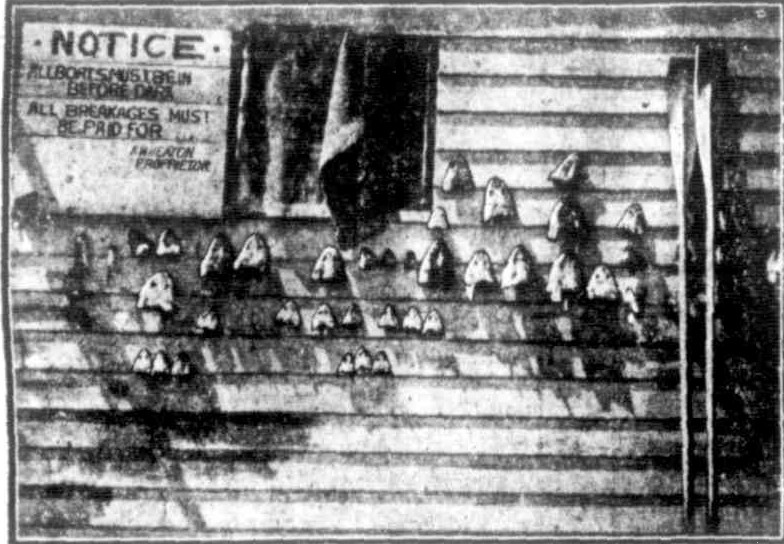
IT PAYS TO ADVERTISE.— This is how a Narrabeen boatman advertises the good fishing grounds there. Proof of this is the gallery of fish-heads nailed to the wall.—'Evening News.' NARRABEEN'S "HEADS" ON THE LONG BAY "FRONT" WRITING HOME. (1923, April 17). Evening News (Sydney, NSW : 1869 - 1931), p. 12. Retrieved from http://nla.gov.au/nla.news-article118844660
The 'letting out of the lake' to prevent floods was also an occasion, all year round, when locals would stand in the newly opened channel to catch the flux of fish rushing out to the sea. The only problem with that was that sharks, lingering outside, also wanted a few mouthfuls of the bounty. However, that didn't stop generation after generation of locals from netting, pun intended, a great feed:
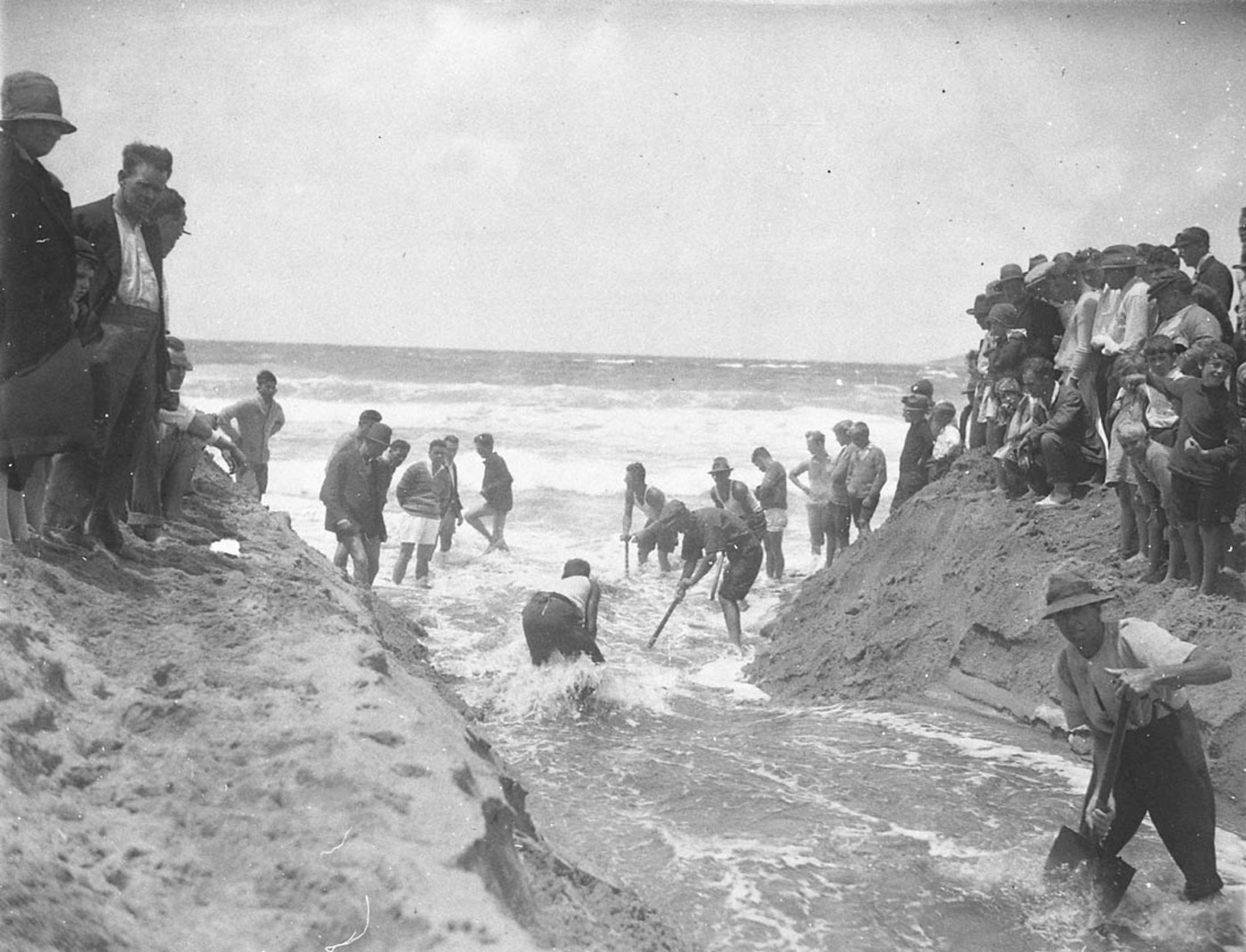
Flood waters burst into the sea, Narrabeen Beach, April 1927, Image No.: hood_06401, courtesy State Library of NSW
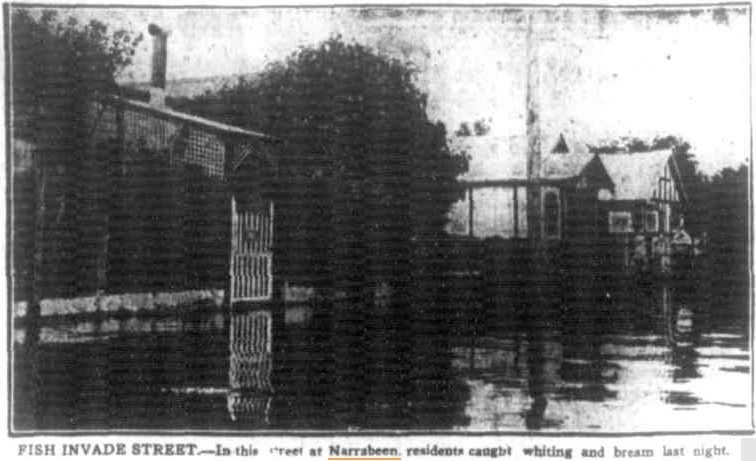
FISH INVADE STREET— In this street at Narrabeen. Residents caught whiting and bream last night - STARVED SCHOOLS— NARRABEEN FLOODS. (1927, November 28). Evening News (Sydney, NSW : 1869 - 1931), p. 13. Retrieved from http://nla.gov.au/nla.news-article118936894
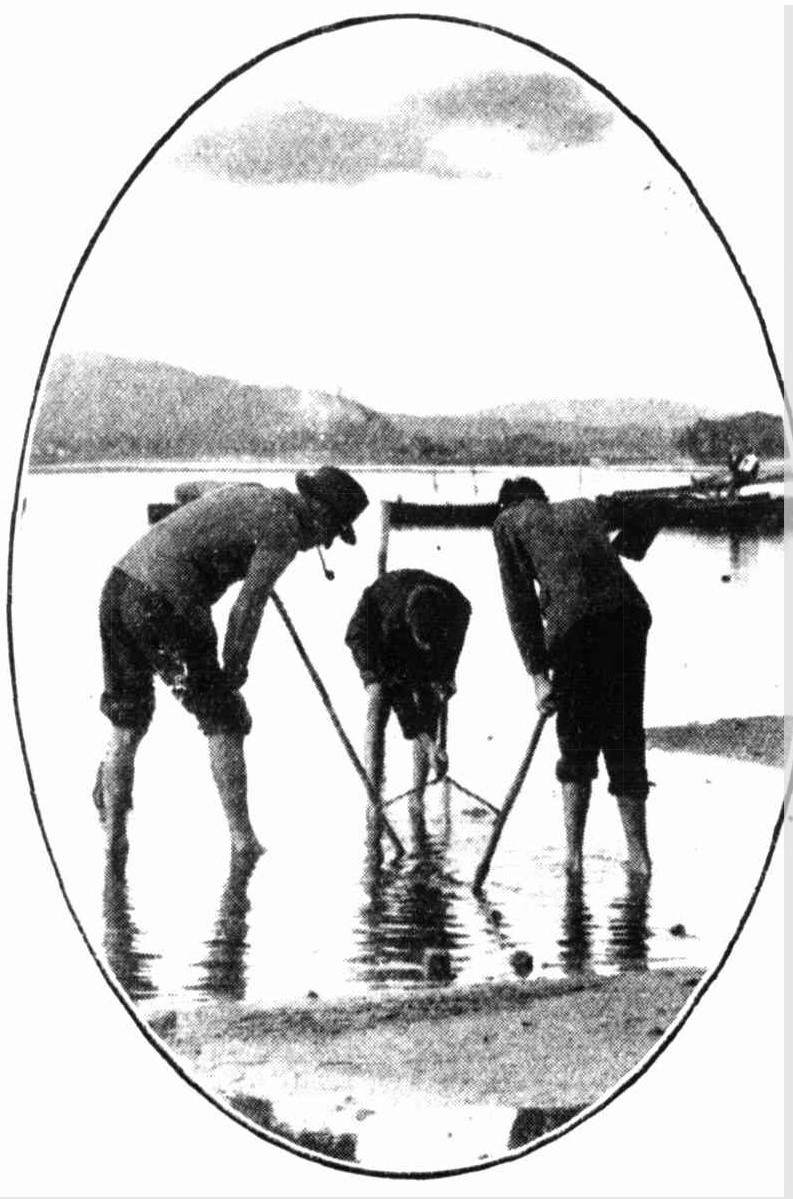
FISHING FOR PRAWNS IN THE NARRABEEN LAKE. Manly Water Supply — And Other Topics (1929, February 6). Sydney Mail (NSW : 1912 - 1938), p. 15. Retrieved from http://nla.gov.au/nla.news-article166259543
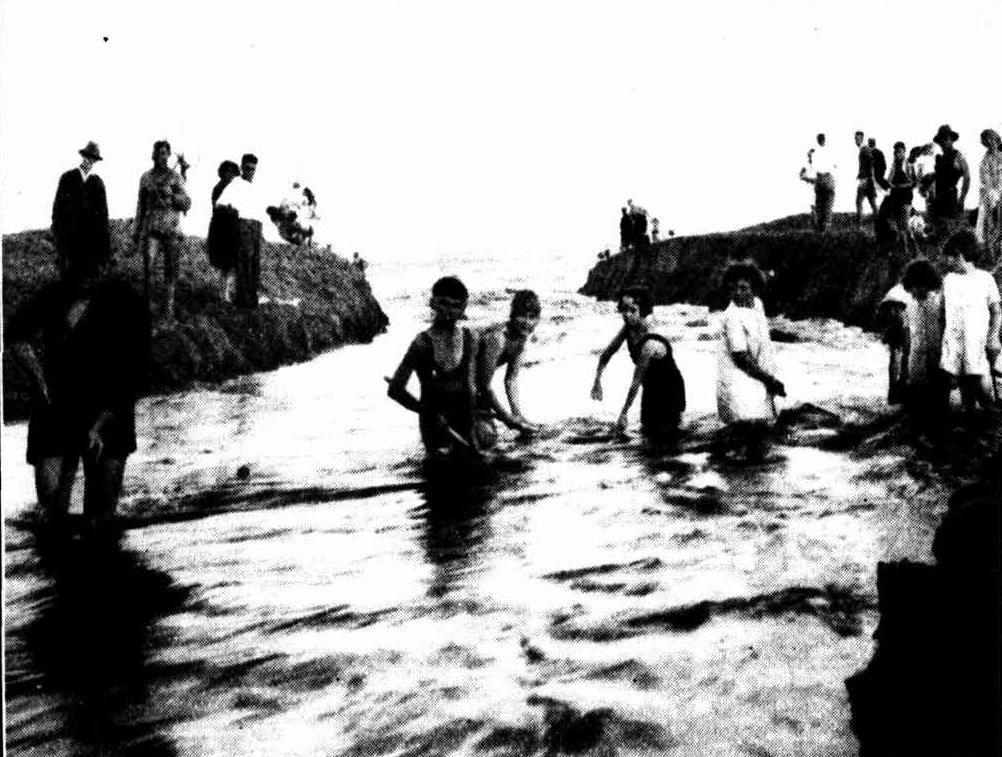
The Great Depression in Australia caused many to move where they could camp and find their own food. Prawning, and knowing where to and when to, by now part of our culture, could feed hungry families with a seasonal feast:
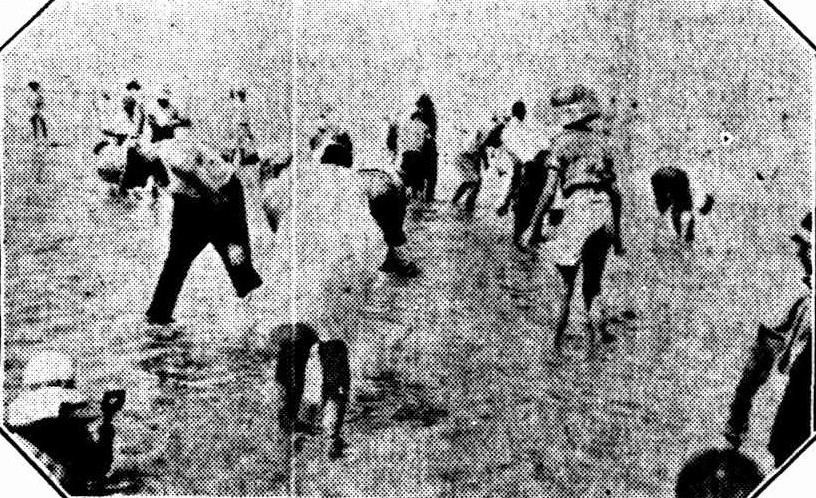
Picture: PRAWNING- AT CUDGEN HEADLAND.Young and old alike enjoy the fun, as well as a reward for their labours. (Mrs. D. Goodrich, Wardrop-street, Murwillumbah, 5s) WITH THE AMATEUR PHOTOGRAPHERS. (1933, January 20).Northern Star (Lismore, NSW : 1876 - 1954), p. 4. Retrieved from http://nla.gov.au/nla.news-article94202825
Prawning. After dark, along the edges of the creeks and the lagoons, flashlights may be seen, reminding one of the will-of-the-wisp. Upon investigation these lights will be found to be clue to the presence of people searching for prawns. Apparently prawns breed in the sea during the winter, and advance up the rivers and lagoons In the spring, and remain through the summer, and the remnant(those that are not caught) go back again to the sea. However, they move about erratically as well, so that no sure time for catching them can be fixed. No fewer than six different kinds may be found associated together in your catch, if you be lucky, and all are equally good to eat. NATURE'S WONDERLAND. (1934, January 4). The Sydney Morning Herald (NSW : 1842 - 1954), p. 23 Supplement: Women's Supplement. Retrieved from http://nla.gov.au/nla.news-article17037646
And then what was obviously needed so that the lagoon, and all in it could survive, finally took place:
FISHERIES. WATERS TO BE CLOSED PERMANENTLY. LICENSING OF AMATEURS. Proposed legislation to protect Immature fish in the estuaries and harbours along the coast was before a meeting of the State Cabinet yesterday. Certain waters will be closed against netting completely. Another feature will be the licensing of amateur fishermen as well as the professional men. The measure will be in charge of the Chief Secretary (Mr. Chaffey), who pointed out at a Cabinet meeting yesterday that it also aimed at making the fisheries administration self supporting In a financial sense. The imposition of a rod licence for the capture of trout, he said, would be enforced. The bill will also remove anomalies in existing legislation. All unlawful nets and gear, and all lawful nets and gear unlawfully used, will on the conviction of an offender be forfeited.
It is proposed to close permanently all net fishing in the whole of the waters of Brisbane Waters, Narrabeen Lake, the greater part of Port Hacking, the entrance waters to Waihi Lake, Lake Macquarie, Tuggerah Lake, and Lake Illawarra. The power is reserved to the Government to declare by proclamation certain parts of Brisbane Waters, and Port Hacking open to net fishing during stated months of the year. The possession of a net in any of the enclosed waters will be declared an offence. There is also another proposal that a regulation may be made to the effect that no person shall take fish from any enclosed waters unless he is the holder of a fisherman's, or amateur fisherman's licence. The fee for an amateur fisherman's licence will not exceed 5/ per annum. Ministers yesterday approved of the principles of the bill, but they requested the Chief Secretary to confer with the various interests concerned regarding the details of the amending legislation. FISHERIES. (1934, April 14). The Sydney Morning Herald(NSW : 1842 - 1954), p. 16. Retrieved from http://nla.gov.au/nla.news-article17057964
Netting fish at Narrabeen Lakes, 29 August 1938 (Prawning nets used), courtesy Mitchell Library, State Library of New South Wales:
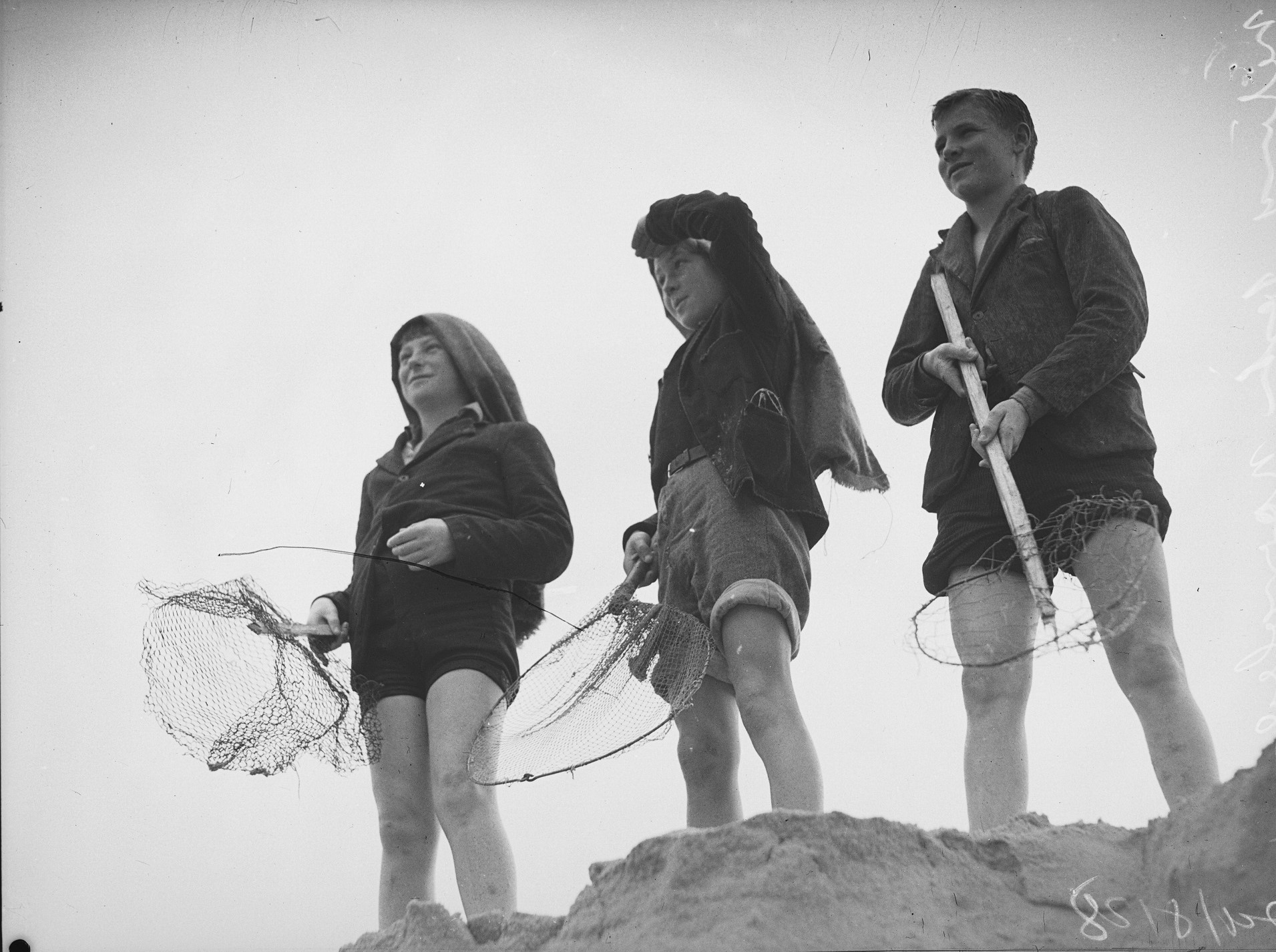
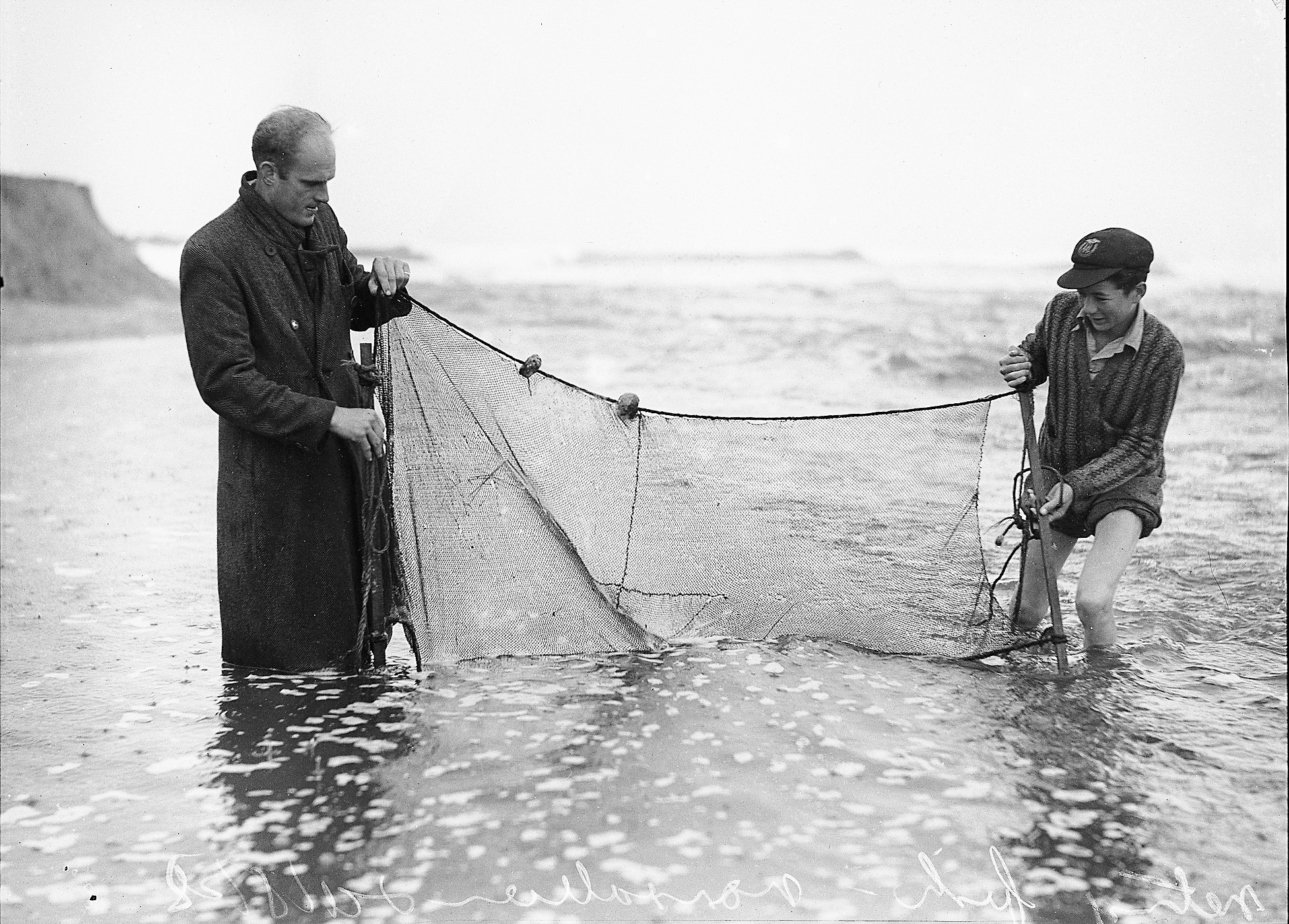
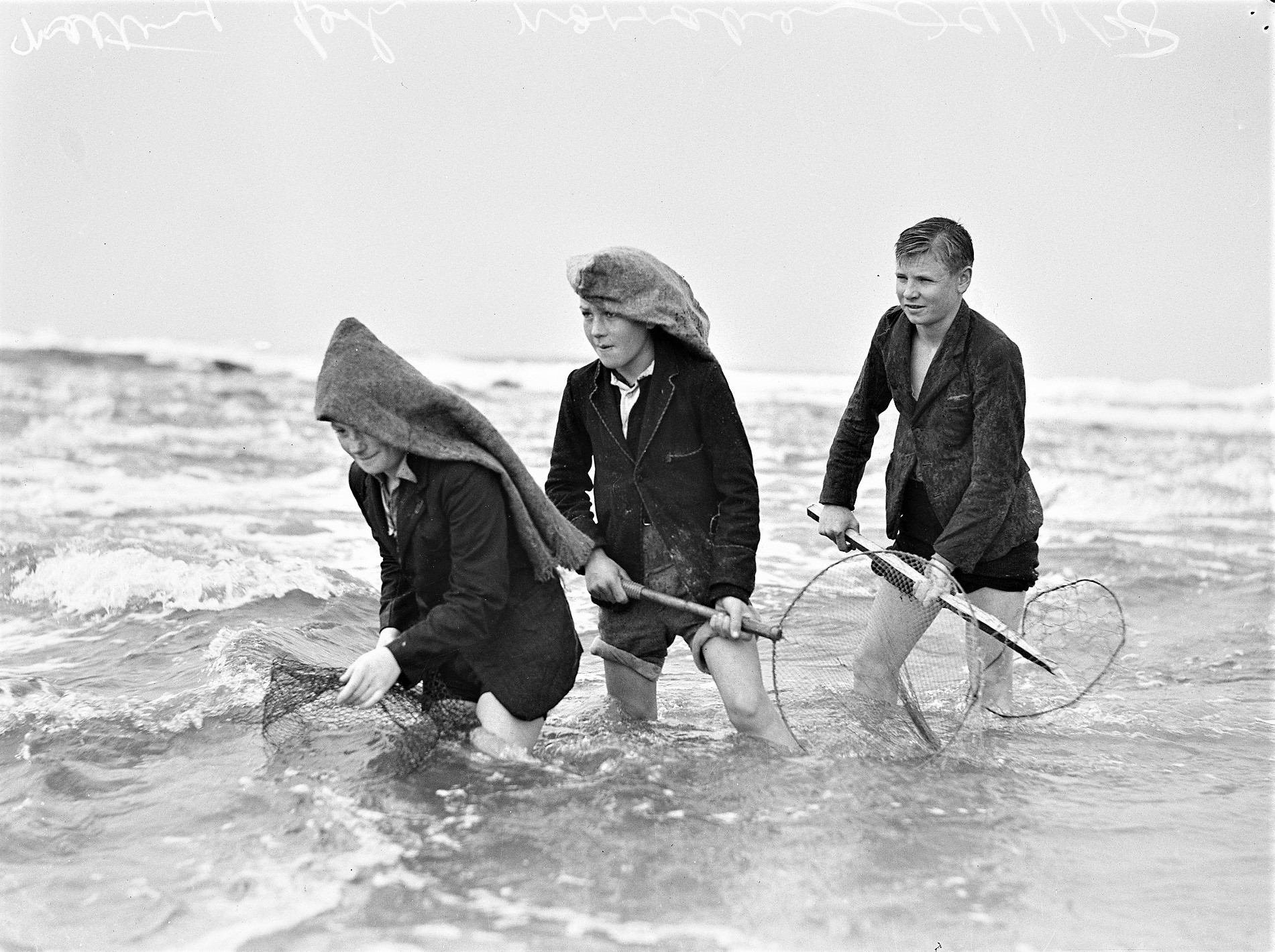
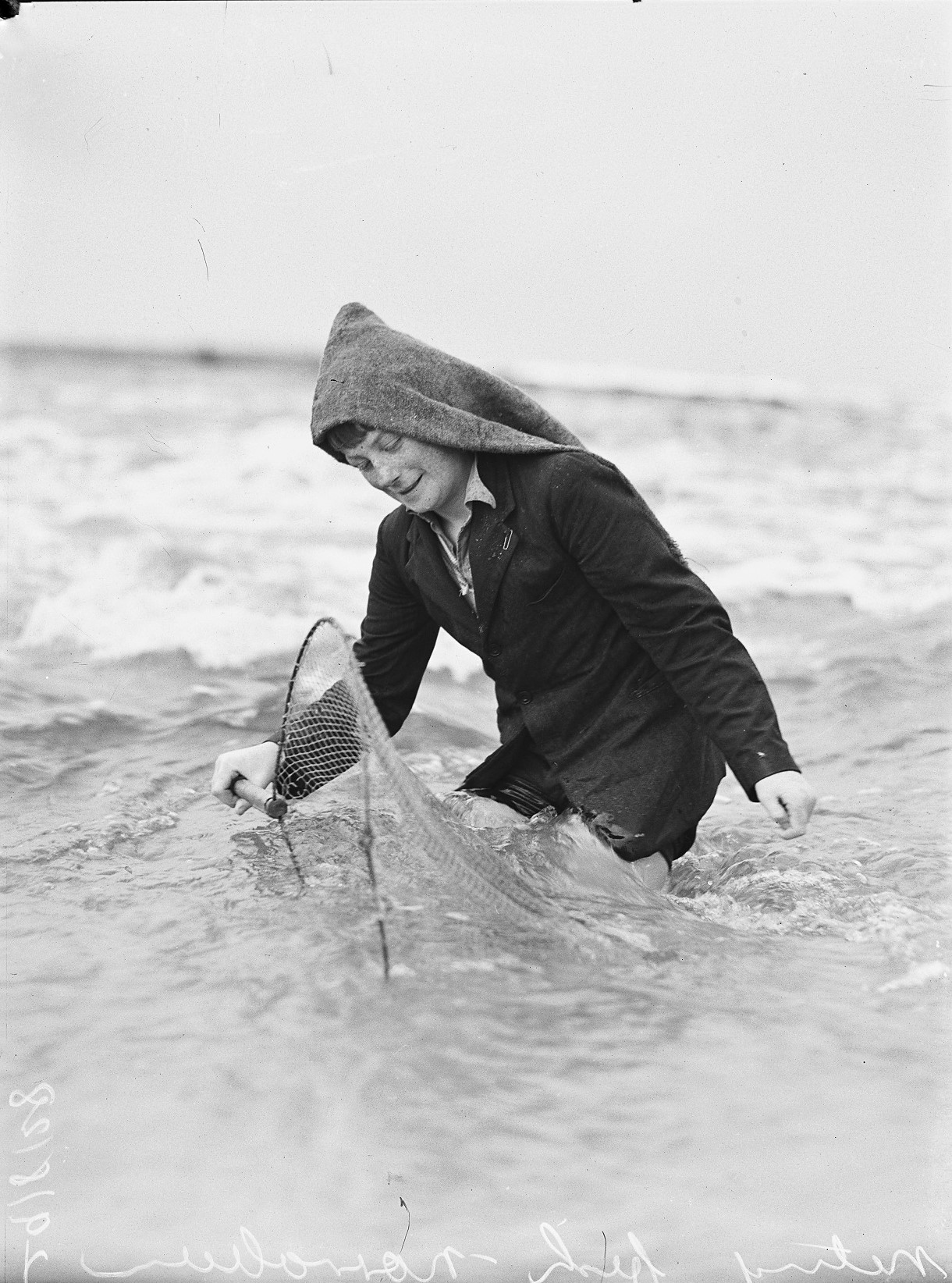
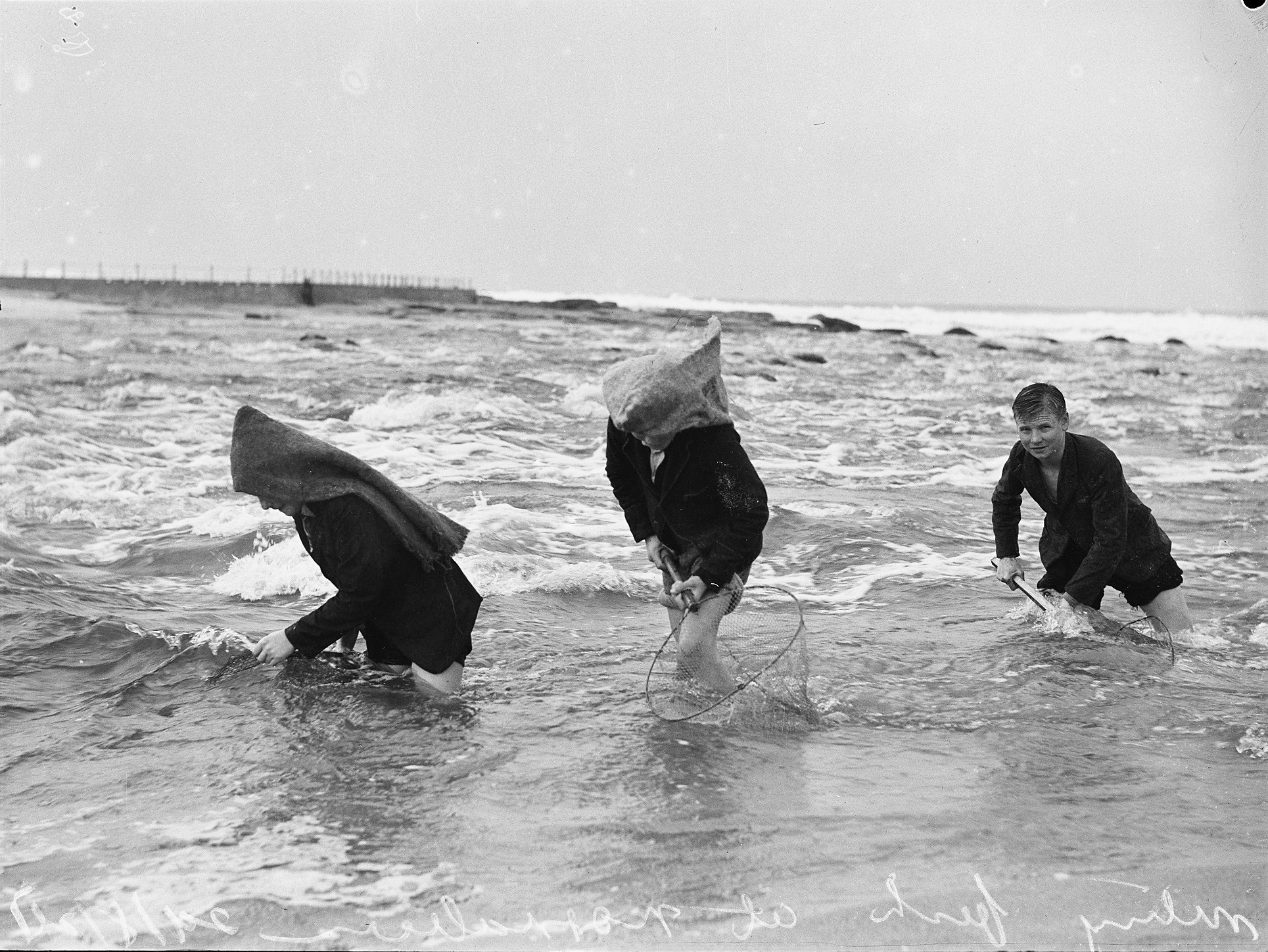
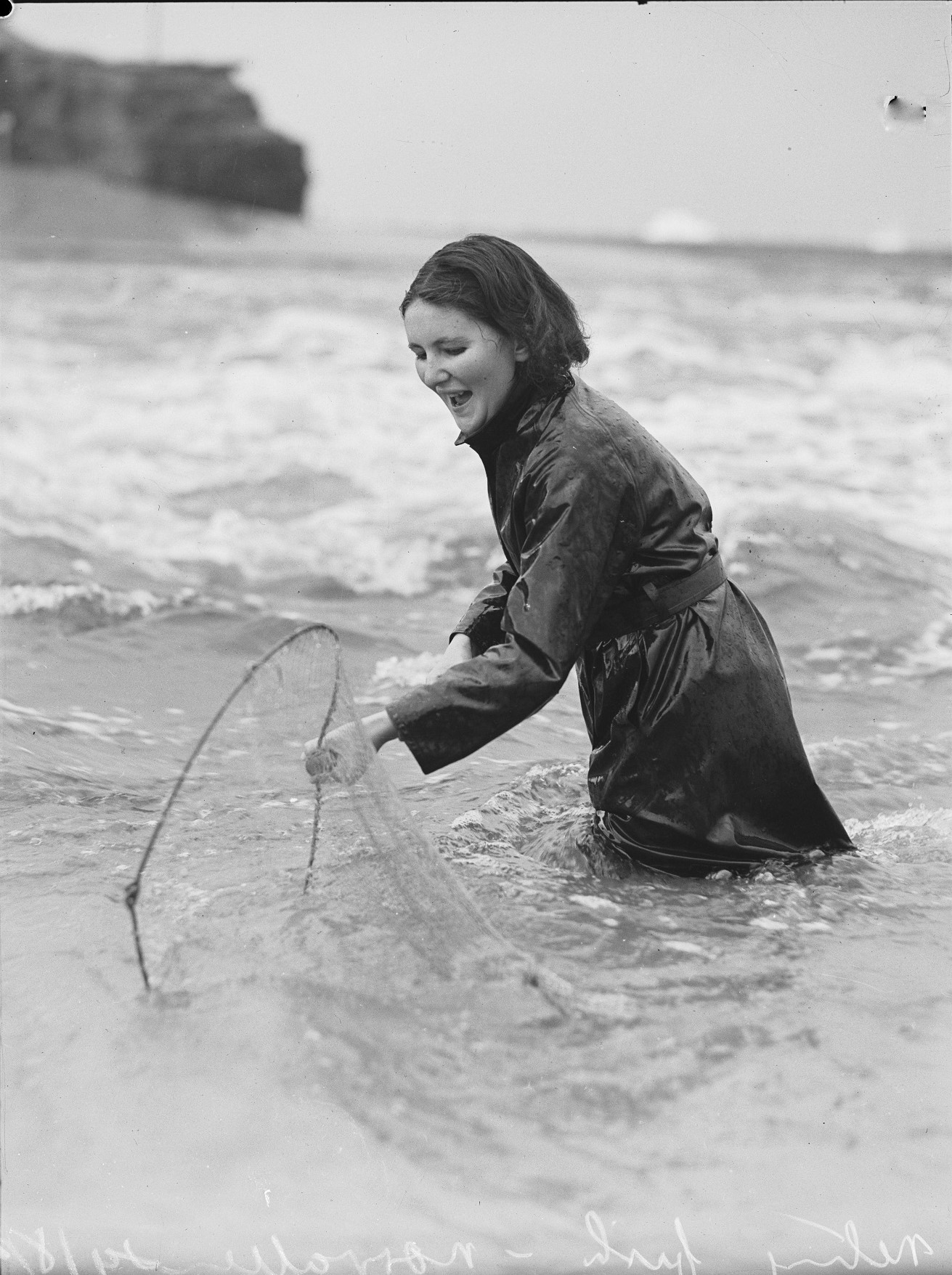
Narrabeen Lagoon faced other environmental destruction during this era - but for now, let yourself conjure up images of people wading as families through the sandy edges of these saltwaters, lights held aloft, two to three days after a summer's or even a winter's full moon...
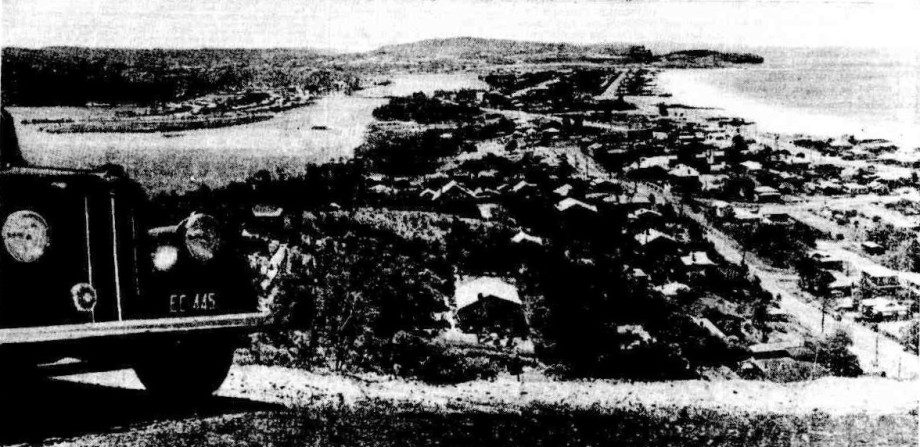
This panoramic view on the north- eastern side of the Collaroy scenic drive, leading to the War Veterans' Home, will be preserved for the public by a decision of the Warringah Shire Council to purchase the land on the edge of the cliff as a public reserve. NARRABEEN VIEW TO BE PRESERVED — GERMANY'S WOMEN WORKERS. (1940, April 5). The Sydney Morning Herald (NSW : 1842 - 1954), p. 12. Retrieved from http://nla.gov.au/nla.news-article17661421
Also available:
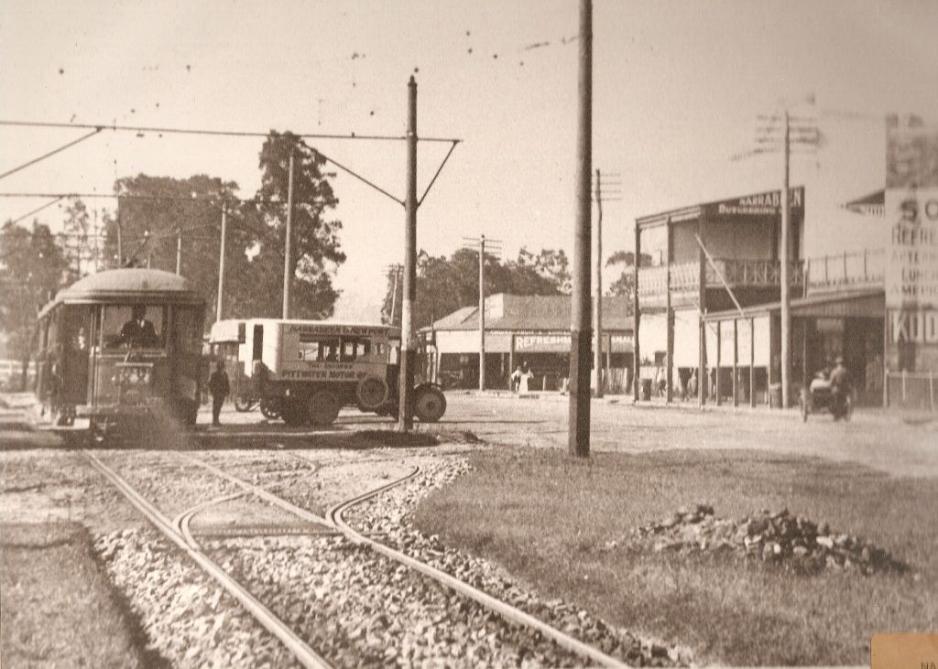
Narrabeen Terminus c1925: From and courtesy of Trams DownUnder Archives at http://tdu.to/30543.att
Extras:
Whaleboats:
NARROW ESCAPE AFTER A SEVERE STRUGGLE.-Two young men, named Robert Brown and Josiah Crowell, seamen who had deserted from the American ship Samuel Appleton, had been brought up on that charge, at the Water Police Court, and were dismissed. They after-wards managed to procure a large-sized whale-boat, carrying about five or six tons of wood, with which they commenced running between Broken Bay and Sydney with loads of timber. On Friday morning last, about six o'clock, they left Broken Bay with about five tons of their usual freight, destined for Sydney but having at nine o'clock reached Narrabeen Head, and being about five miles from the land, the boat was filled by a heavy sea, and immediately sank. Brown took to swimming, but never saw his companion afterwards. The survivor managed to swim whilst holding on to an oar, until eleven o'clock, when he was greatly exhausted and almost paralysed with cold. At this time he was picked up by the master of the ketch Valentine Ward, but there were scarcely any symptoms of vitality. The master of the ketch then cruised around in order if possible to discover and pick up the missing man, his search was in vain. Crowell, the one lost, was an American by birth, and about twenty-six years of age ; Brown is about twenty-one.-Herald, July 13. ACCEPTED TENDERS FOR RUNS. (1858, July 24). The Moreton Bay Courier (Brisbane, Qld. : 1846 - 1861), p. 4. Retrieved from http://nla.gov.au/nla.news-article3721221
THE FEDERALTRAWLER. LAUNCHED THIS MORNING. AT COCKATOO ISLAND.
The first trawler ever built in Australia was launched at a few minutes past 9 o'clock this morning, at the Government Dock Yard, Cockatoo Island. Properly speaking, the new steamer, which has been named Endeavour, may be styled a fisheries investigation vessel, designed either for trawling purposes, or for Investigating the fishing grounds of the open sea. She is fitted with a laboratory, and the scientific instruments used in the investigation of both deep sea and inshore fishing. This morning's ceremony was witnessed by about 300 persons, including a large number of ladies who journeyed to the dock yard in the steamers Captain Cook and Bronzewing. Among those present were Senator Keating (Minister for Home Affairs) and Mrs. Keating (who performed the launching ceremony), Mr. C. A. Dee(State Minister for Works), Messrs. Frank Farnell (chairman of the New South Wales Fisheries' Board), H. V. Dannevig (Commonwealth Inspector of Fisheries),G. A. Miller. M.L.A., J. Storey. M.L.A., Col. Miller, Capt. Cresswell (naval director), Messrs. G. Oakshott (director of works, Home Affairs Department), W. J. Hanna (Under-secretary Public Works), R. R. P. Hickson (chairman Harbor Trust), H. F. Norrie (secretary HarborTrust), J. Brodie (secretary Fisheries Commission), J. Baxter (Acting-Collector of Customs), Walter Reeks (who designed the new vessel), A. Christie (supervisor of the building operations), A. E. Cutler (superintendent of the Government Dockyard), Borland (assistant superintendent), J. V. Tillett (Crown Solicitor),J. Laws (Mayor of Balmain), H. D. Walsh(Harbor Trust), and Captain Newton (Navigation Department).
Punctually at 9.15 a.m. Mrs. Keating smashed a bottle of Minchinbury champagne, and cut the ribbon with a beautiful pair of gold scissors specially made for the occasion. At once the vessel began to move and glide gradually Into the waters of high tide as gracefully as a swan. It was a magnificent launching, perfect in every detail, and the 'Endeavor' varied scarcely a hair's breadth to starboard or larboard as she sailed majestically to her first dip in waters of the historic port. So perfect was the ceremony, that the company was reused to the enthusiasm of loud cheering, and vigorous handshaking, and congratulations all round. The sun shone out splendidly, and the day was perfect. An adjournment was made to the luncheon room shortly before 10 a.m. Mr. Lee, Minister for Public Works, proposed the toast of Mrs. Keating's health, and congratulated her warmly upon the success which had attended the launching ceremony. She had, in his opinion, christened a tight and worthy little ship, that would prove a credit to the Commonwealth. Senator Keating, who responded, after thanking the company, on behalf of his wife, said the day was one upon which Mrs. Keating would look back with fond recollection,because it was the beginning of the development of the fishery resources of Australia.
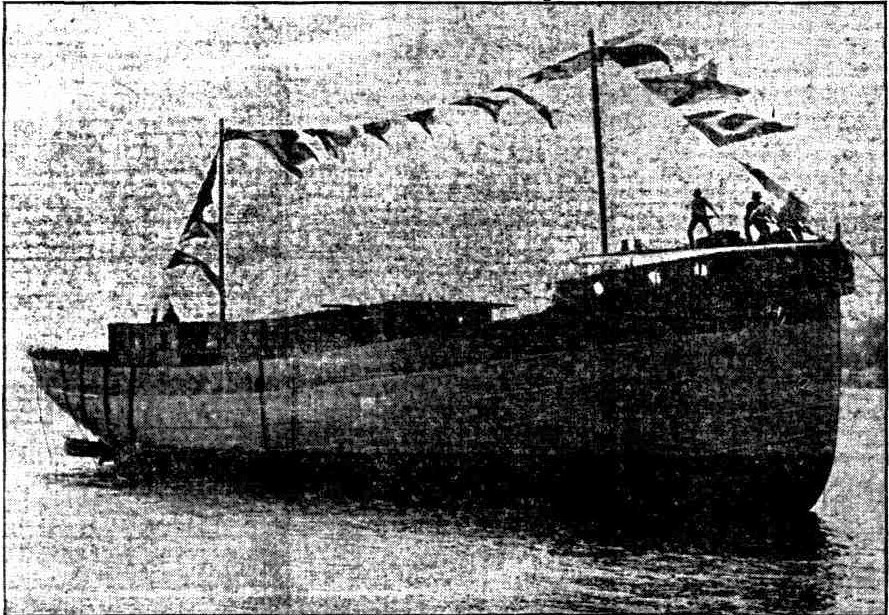
The Federal Trawler Endeavour,WHICH WAS LAUNCHED FROM THE GOVERNMENT DOCKYARD, COCKATOO ISLAND, THIS MORNING.
The work of building the steamer had been accomplished in record time, as the keel was only laid down on June 1. The expedition that characterised the building had really been remarkable, and he had been assured that the same expedition would be observed until the vessel was delivered to the Commonwealth Government, according to contract. Although the Endeavor was called a trawler, she was not intended to be used as such in the ordinary acceptation of the term. The vessel would not be used in the way trawlers were organised in the North Sea for commercial purposes. She was a fisheries boat for the investigation of the resources of the seas that washed 8000 miles of the shores of the great Commonwealth of Australia. With a sea like that, and from what they already knew, it was not absurd to imagine that we had near our coastline in many localities great and teeming resources as far as our fisheries were concerned. They had seen what had been done in Canada, Japan, and other countries with regard to the development of fisheries. There they had found acres upon acres of the seas that from a commercial point of view had proved almost more profitable than the acres ashore. There was no reason why they should not have, a similar experience here in. Australia. This was but the beginning of a great event. The new vessel would not only conduct trawling and scientific investigation, but she would be manned by officers capable of carrying out the necessary scientific- work. After that it would be for the people of Australia to follow up what the Commonwealth Government was doing, and pursue the matter from its commercial standpoint. In his opinion, they should have a reasonable proportion of their population habituated to work on the deep blue seas, of the Commonwealth. The time might come when they might fear danger of foreign aggression. He hoped that time would be as distant as possible. But the time certainly had come when they should be prepared for such an emergency, and they must lose no time in bringing up a hardy and sturdy race of seafarers. (Cheers.) They sprang from a good stock, that had always been at home on the blue and deep water, and there was no reason why, coming from such a stock, they should not be able to carry on the same traditions as that great and noble stock had handed, down to them. The work they had begun was but the beginning of what true Australians hoped to be a great development in the near future. It would be the beginning of a defence which all would welcome. (Cheers.)Turning to other matters. Senator Keating congratulated the designer of the vessel and those who had had charge of its construction. They all felt confident that they would have a ship that not only the Commonwealth Government, but the .people of Australia, would be proud of. 'Apart altogether from fisheries, the launching of the Endeavor that morning marked a new departure in the history of the shipbuilding of the Commonwealth. It was the first craft of Its kind ever built here, and it augured, well for the future, for they would yet build vessels of a larger type that would not only carry on commercial work, but vessels that would be able to defend the shores and harbors of Australia. That work had a significance and importance that would appeal to the whole of Australia. Senator Keating then proposed 'Success to the Fishing Industry of Australia and to the ship Endeavour.' Mr. Dannevig, in responding, said that in Australia they did not yet realise properly what fisheries were. Even In other countries where they had been fishing for a great many years they still were building investigation vessels, so that, therefore, we out here were not merely experimental, we were simply following the example of other countries. Fish and fishing was not managed here in the way it should be, and he hoped to see the Government take the matter over in such a way that the people would be able to have nice cheap and wholesome fish for breakfast. There was a big thing in cheap and wholesome food for the people.
Mr. Reeks also spoke. He said he had already designed 213 boats, so that he looked affectionately upon the Endeavor as one of the family. He thought, however, special mention ought to be made of the happy and cheerful way matters were carried on at the Island. The head officials and the workmen were in this respect entitled to the highest praise that it was possible to give them. Messrs. A. Christie, supervisor of the work, and A. E. Cutler, superintendent of the dockyard, also responded, and the proceedings terminated with the usual compliment to the chairman. The new vessel was afterwards towed around to the wharf, preparatory to fitting her engines and appointments, which are now being constructed in the workshops at the dockyard. During the launching ceremony the Sobraon boys gathered in the rigging, and cheered lustily as the Endeavour glided gracefully Into the water. THE FEDERAL TRAWLER. (1908, August 27). Evening News(Sydney, NSW : 1869 - 1931), p. 3. Retrieved from http://nla.gov.au/nla.news-article114761039
It is somebody's duty to remind the Government that as far back as 1878 a move was made to get a marine biological station for the State, and that a sum of money was vested in Professor Haswell and other University authorities as the nucleus of a fund to make the scheme practical. IT is understood that the amount available Is now about £1500, but some twenty years ago, when the late Professor was one of a deputation to the late Sir William Lyra, then Premier, and asked for about £20.000 to establish a laboratory at Watson's Bay, the worthy knight nearly collapsed at the magnitude of the request. He promised nothing, and fulfilled his promise. Since then, with the exception of an occasional fillip to the public Interest, the subject has languished. It was revived during a visit to the Taronga Zoo by some earnest advocates of the expansion of our fisheries a few days ago. A suggestion was made, after seeing the wonderful Improvements at Taronga In connection with the aquaria there, and the new arrangements made by Col A. Spain, chairman of the Taronga Trust, for providing a gravitation supply of marine water for the seal pond and the marine fish tanks, that the biological laboratory might be started at or near the Zoo. Knowledge of our fish movements and their foods, the reasons for shortages of fish In certain waters, and the Institution of means to restore depleted fisheries are part of the purpose of a marine laboratory under skilled biologists' supervision. Professor Haswell and other eminent biologists have gone, but their work should not be allowed to die. Any Government that sees the wealth In our fisheries and oysteries and the avenues they afford people to prosper In the handling of them should resuscitate the subject, and thus leave a perpetual memorial of Its readiness to advance knowledge with the commercial future of the State. If Taronga does not prow to be ideal for the purpose with its new facilities for gravitating marine water, then some other place should be chosen. That forgotten £1500 should be used.—CHARLES THACKERAY. FORGOTTEN £1500. (1929, June 4). Evening News (Sydney, NSW : 1869 - 1931), p. 8. Retrieved from http://nla.gov.au/nla.news-article117732162
MR. CHARLES THACKERAY.
Mr. Charles Thackeray, a well-known Sydney journalist and an authority on fishing, died suddenly yesterday aged 71 years. He had been editor of the "Police News," the official publication of the N.S.W Police Association, for the past 18 years.
Mr. Thackeray was born at Bellambi, South Coast, and was educated at St. John's School, Darlinghurst. He became a school teacher at the early age of 14 years, and entered journalism 11 years later. He served on the literary staffs of the "Sydney Morning Herald," "Sydney Mail," and the "Evening News" before he became editor of the "Police News."
Fishing was his hobby from childhood. He wrote extensively on amateur fishing, and was the founder of the Amateur Fishermen's Association. He also took a leading part in the Rod Fishers' Association. He is survived by Mrs. Thackeray, two sons, Messrs. Norman and Harold Thackeray, and two daughters, the Misses Heather and Joan Thackeray. MR. CHARLES THACKERAY. (1938, June 6). The Sydney Morning Herald (NSW : 1842 - 1954), p. 7. Retrieved from http://nla.gov.au/nla.news-article17496810
Big Money in Prawns
By E. COLIN DAVIS
A good haul for the cooker. THE devourer of the succulent prawn-a too-rare crustacean nowadays-will be surprised to learn that the catching and preparation of the creature entail a surprising degree of skill and hard work. From the shallow lakes of Tuggerah, Terrigal, Gosford and Toukley come most of Sydney's prawns though supplies dwindle sharply over the Xmas and New Year period, when the local demand from a population supplemented by thousands of visitors, becomes so great that only meagre quantities get as far as the city markets.
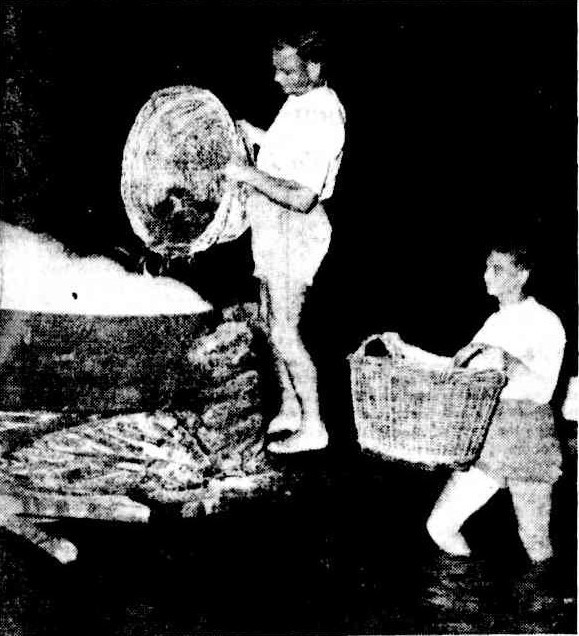 A familiar sight after sunset on the Lakes in holiday-time is the hundreds of bobbin. lights which indicate the endeavours of groups of "amateurs'' to catch a "feed" of prawns. But from October till late in March the professional prawner, the man who makes prawn-fishing his living, works to a set routine night after night, weather permitting, and misses the thrill which urges the amateur to fresh effort.
A familiar sight after sunset on the Lakes in holiday-time is the hundreds of bobbin. lights which indicate the endeavours of groups of "amateurs'' to catch a "feed" of prawns. But from October till late in March the professional prawner, the man who makes prawn-fishing his living, works to a set routine night after night, weather permitting, and misses the thrill which urges the amateur to fresh effort.
On the night before each full moon, licensed prawn fishermen in the Tuggerah district submit their names for a draw for the narrow entrance where the Lakes join the ocean. Three nights after each full moon the draw commences and each night while the "dark" lasts five men are allowed to set their nets against the prawns on the run-out tide. Usually about 35 men take part in the draw, so each man's turn comes about once every seven nights. Huge hauls of prawns are taken from this narrow channel.
IN the Lakes themselves, however, the prawners are at work every night and while their hauls are small compared with the Entrance bags, they catch enough to earn a living. But the wily prawn goes off about March and most of the prawners turn to fishing off the coast.
Most of Tuggerah's prawn fishermen have been at the game since early childhood and they are a healthy, hardy crew.
"While the prawn season is on we make big money," said one fisherman, "but we realise it is a rather unstable life. Some of us insure against the uncertain future by investing our money whenever we can, mostly in Commonwealth securities."
Typical of these fishermen is 31year-old Alf Payne, of Pacific Street, Long Jetty. He has been netting prawns since he was 11. Four hundred yards off-shore in the shallow water at Long Jetty Payne has erected a most unusual "floating fire."
Here old tyres, wood and sump-oil create a fierce fire beneath a 100gallon tank, and within a few seconds of being netted the prawns are cooked, cooled and ready for consumption. Some King prawns are caught in the Lakes, but "school prawns" or "greasy backs" are the most common.
The average net used by the professional fisherman is 150 yards long, nine feet deep and has a 1 ½ inch mesh. The net is set and drawn back at both ends in a wide circle until the catch is brought up against a "fence". . . another net pegged in the water. Fish are released from the catch and the prawns arc then placed in a "floater" until ready for cooking.
IMMEDIATELY they are cooked and cooled, they are either sold to the local shops or cased ready for transport to the city markets. Some fishermen object to sending their catches to the markets because they often have cases, rejected without a reason being given and have no means of ascertaining that their consignments were not in order.
"We don't get a fair deal now that the Government has control of the markets," said one. "One day I sent three cases of prawns to the market and, although they all came from the same catch and were all cooked at the one time, one of them was rejected. This smells a bit fishy to me."
Sometimes the nets bring in good-sized fish, but more often the catch includes such unwelcome additions as electric eels, fortescue or conger eels. The electricity carried in the electric or "numb" eel is so strong that a shock can be felt by touching the net in which it is caught.The pain from the sting of the small fortescue is almost unbearable and, strangely enough, never abates (despite the most drastic treatment) until the tide turns. The really dangerous fellow, however, is the big conger eel, sometimes almost as big round as a man's waist.
Payne related how one night in the darkness he pulled a conger eel into his boat with him. "There wasn't enough room for both of us," he said, "so I got out and left him to it!" Big Money in Prawns. (1947, February 15). The Sydney Morning Herald (NSW : 1842 - 1954), p. 9. Retrieved from http://nla.gov.au/nla.news-article27906803
And this too belongs here - some fantastic news for Narrabeen Lagoon, and as already stated- all connected to her:
NEW FUTURE FOR NARRABEEN LAGOON - Tuesday 1 April 2014
Deputy Premier Andrew Stoner today announced the establishment of a State Park at the Narrabeen Lagoon in Sydney’s Northern Beaches. Mr Stoner made the announcement with the support of three local Members of Parliament, Pittwater MP Rob Stokes, Wakehurst MP Brad Hazzard and Davidson MP Jonathan O’Dea, whose electorates take in and border the popular lagoon.
Mr Stoner said the creation of the Narrabeen Lagoon State Park reflected the significance of the lagoon and surrounding public lands to the people of NSW.
“Narrabeen Lagoon State Park will encompass the largest of four coastal lagoons in the Warringah Local Government Area and the majority of Crown Land within the catchment,” Mr Stoner said. “Narrabeen Lagoon is a precious asset that affords a range of recreational, tourist and sporting activities all within a unique environment less than 30 kilometres from the Sydney CBD.
“The establishment of the State Park fulfils a commitment made by our local MPs who, on behalf of their communities, have shown great support for protecting and preserving Narrabeen Lagoon.”
Mr Stokes, whose Pittwater electorate contains the lagoon, said: “The establishment of the State Park is recognition of the area’s important public recreation, tourism and environmental qualities.”
“I’m delighted the Government has responded to the wishes of our community and is delivering on this proposal,” Mr Stokes said.
“Narrabeen Lagoon is an invaluable natural asset and we must ensure it’s available for future generations to enjoy.”
Mr Hazzard said: “This has been a battle worth having. This State Park will ensure the natural, tourism and recreational values of the lagoon and its catchment are nurtured and protected.”
“The Friends of Narrabeen Lagoon and the local community have worked tirelessly to achieve this,” Mr Hazzard said.
Mr O’Dea said: “It should be a big step towards a more holistic framework to manage the patchwork of reserves around the lagoon and better meet future funding needs.”
Mr Stoner said an Advisory Committee had also been established to help steer the management and direction of the new State Park.
The advisory committee will comprise:
- Chairman, appointed by the Deputy Premier
- Representative of Trade & Investment, Crown Lands
- Representative of the General Manager, Warringah Council
- Recreational User group
- Community Representative
- Representative of the Chair Metropolitan Local Aboriginal Land Council
- Representative of NSW Fisheries
- Representative of the Office of Environment and Heritage (National Parks)
“The committee will examine management issues and opportunities, funding needs and the potential for activities within a sensitive natural environment,” Mr Stoner said. “This is a great start, and I wish the committee well in their work to ensure Narrabeen Lagoon State Park continues to provide for the community now and into the future.”
See: Narrabeen Lagoon State Park - NSW's Newest Investment In The Future
Marine fish stocking
August 14, 2014: The NSW Government DPI is implementing a marine fish stocking program in selected estuaries to enhance recreational fishing opportunities. The program will begin this summer and will see around four million juvenile Eastern king prawns stocked in 10 estuaries along the coast.
This stocking program follows on from previous research trials of stocking mulloway and prawns, which evaluated ecological aspects and effectiveness of marine stockings. These successful stockings provided essential information for a comprehensive environmental assessment and development of a management strategy for implementation of an ongoing marine stocking program.
All stockings will be in line with the NSW Marine Fish Stocking Fishery Management Strategy, which ensures that fishing stocking is conducted responsibly while minimising environmental risk. The stockings will be closely monitored by fisheries scientists to ensure environmental and ecological sustainability.
The following 10 locations have been identified as potential stocking locations for Eastern king prawns this summer:
Curalo Lagoon; Wallagoot Lake; Nelson Lake; Lake Tabourie;Burrill Lake; Lake Conjola; Swan Lake; Narrabeen Lagoon;Wamberal Lagoon; Khappinghat Creek.
Plans are also underway to initiate Mulloway stockings in the future, which will involve collecting wild caught broodstock and acclimating the fish to hatchery conditions before being ready to spawn.
For more information on marine fish stocking emailfisheries.enhancement@dpi.nsw.gov.au.
From: www.dpi.nsw.gov.au/fisheries/recreational/info/stocking/marine
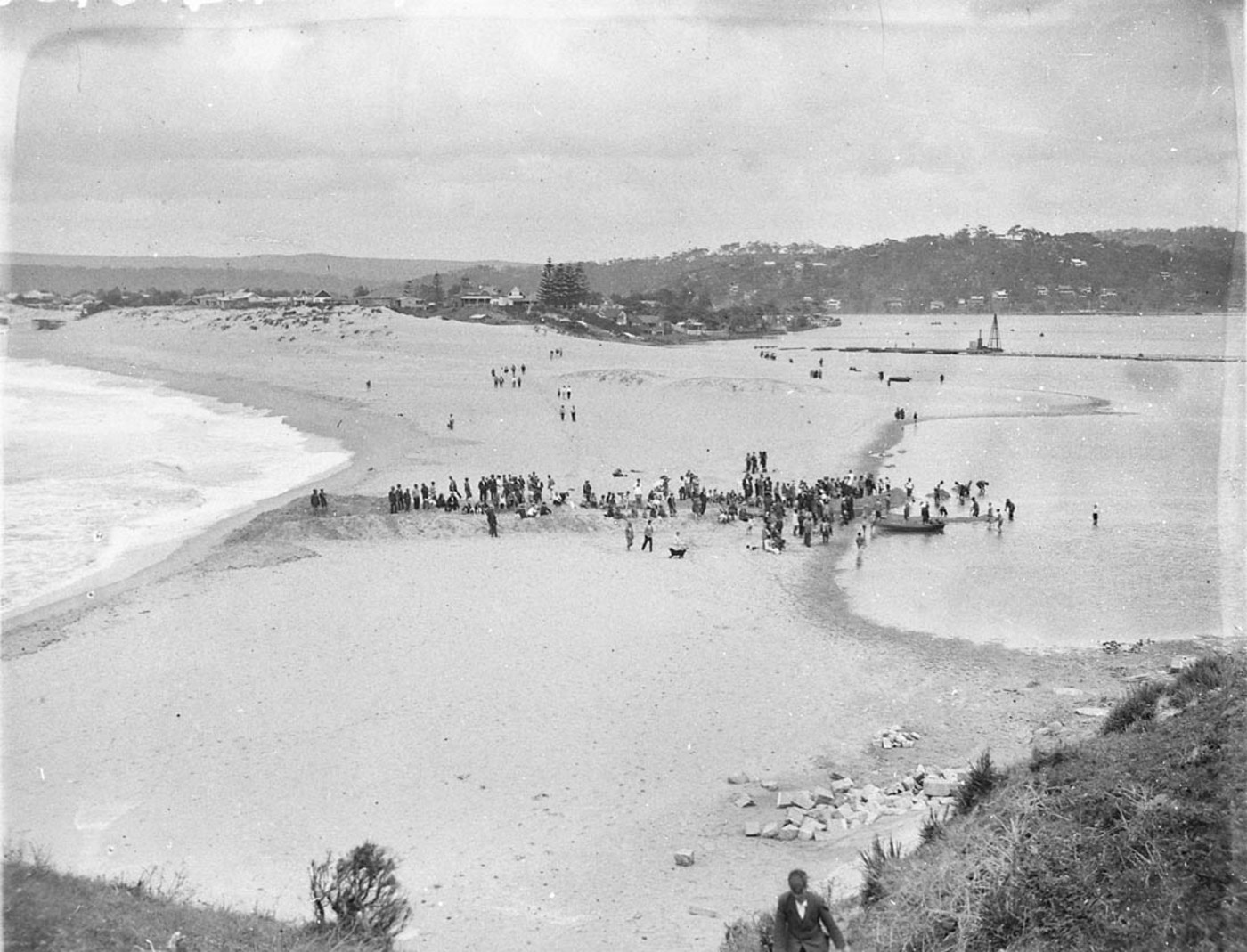
Crowds around a new flood control channel from Narrabeen Lake to sea - April 1927, Image No.: hood_06408 (by Sam Hood), courtesy State Library of NSW.



